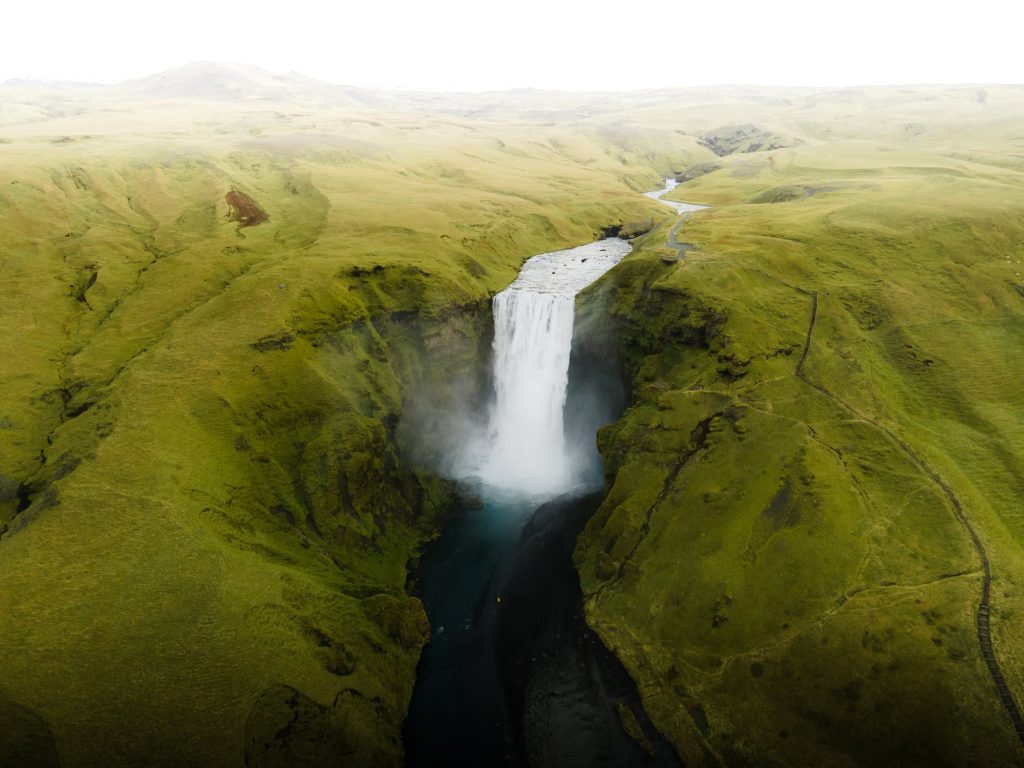
by DGR News Service | Apr 17, 2023 | ANALYSIS, Alienation & Mental Health, Human Supremacy, The Problem: Civilization
Editor’s Note: The Earth is dying. The facts are there. Yet, not a lot of people take it seriously. Otherwise, we would have seen a much greater action around it. The following post tries to explain this phenomenon by the concepts of enlightenment, wétiko, denial of reality and maximum power principle, and by challenging the preconceived notions in our civilization.
By Erik Michaels/Problems, Predicaments and Technology
My last post about enlightenment was to describe the simple fact that enlightenment does not bring happiness or fulfillment but is a stripping away of innocence and naïvety. Enlightenment is what experience and reality replaces idealism with. My own experience informs me that I must choose to look for positives rather than the negatives which initially overwhelm me. I must turn away from the anthropocentric perspective which I am naturally biased with. In this manner, I can then begin to look at the collective set of predicaments our species has brought forth and see it for the unvarnished truth that it really is. My writings aren’t unique, as many others write about the same topics as I do. However, very few actually point to the actual roots of these predicaments the way I do, and perhaps denial of reality (see link below) is one reason why. Doing so requires much grief work along the way, realizing the true nature of how we got to this point.
I brought the concept of wétiko into that post (as well as many others), and an article from Max Wilbert about Protect Thacker Pass made me realize that I should probably expand on this concept as well as point out the reasons for it. In the article, he quotes Jack D. Forbes, and then goes on to explain here, quote:
“‘The wétiko psychosis, and the problems it creates, have inspired many resistance movements and efforts at reform or revolution. Unfortunately, most of these efforts have failed because they have never diagnosed the wétiko as an insane person whose disease is extremely contagious.’
That contagion is dangerous. None of us are immune. This is why all of humanity’s most lasting stories, from the Wendigo to Star Wars, tell of internal conflict. Whether you call it greed, temptation, evil, the Dark Side of the Force, or anything else, humans have the capacity for doing wrong.“
It was that very part which is so powerful that made me see that I need to expand on it to bring the reality of precisely what it is into the forefront. Most people brought up in western civilization cannot “see” wétiko because they are indoctrinated against it. (Go here for an indepth and complete description of what civilization is.) Elementary schools teach history in such a way as to present Europeans as the “good guys” and North American Indians as the “bad guys” when in reality, it is the other way around from an ecological standpoint. European cultures invaded North American Indians’ lands and used their superior technology to wipe out or marginalize the Indians wherever resistance was mounted. This same colonialism has presented itself time and time again all over the world, where a force with superior technology has wiped out culture after culture and relegated such cultures to history. The trouble with this is in the fact that those cultures actually lived in a far more sustainable relationship with their environment than most all of us today.
Most of us in western civilization look at land ownership, agriculture, and civilization itself as part of who we are, including our economic systems and cultural systems. Until one learns the reality about these systems being unsustainable, one almost never questions their necessity or their presence. Once one questions the presence and the necessity of continuing these systems, one becomes aware of the fact that humans lived without these systems for most all of our entire history except the last ten to twelve thousand years (in the case of civilization) and only the last 200 years or so has been industrial civilization.
“The less you think about your oppression, the more your tolerance for it grows. After a while, people just think oppression is a normal state of things. But to become free, you have to be acutely aware of being a slave.” ~ Assata Shakur
This quote is poignant due to precisely the predicament we find ourselves in. Now, I still do not think that 8 billion or more human beings can live on this planet in a sustainable manner, regardless of how they live simply due to the fact that in order to provide habitat to that many humans more or less requires an amount of energy for habitat greater than can be provided through renewable resources (provided by photosynthesis). Still, there is no doubt in my mind that the humans who are alive today could live far more sustainably than those of us who live the Western Civilization lifestyle. The oppression most all of us face has to do with technology use, civilization, and the economic system currently being used, among many other items commonly discussed in the social justice realm.
Whether one calls the set of circumstances we find ourselves in a predicament, a multi-polar trap, dilemma, or something having a similar meaning as these, this set of circumstances is far different than a problem. This set of circumstances cannot be solved or answered with a simple solution or even a set of solutions. Even if the entirety of human population right now could cease all anthropogenic emissions immediately (something which is utterly impossible), ecological overshoot and climate change and many other symptom predicaments of overshoot would continue unabated (see Denial of Reality for the evidence). While eliminating emissions would be a really nice start to mitigating climate change, as long as overshoot is allowed to continue, we would have accomplished very little. The only way to reduce overshoot is to reduce technology use – in other words, we will need to promote degrowth and the abandonment of the system of civilization, because it is unsustainable. Civilization is supported by technology use and cannot exist without it. Even back when our species lived mostly in a sustainable fashion, we only did so after causing destruction first (usually in the form of wiping out the species we relied on for our very existence) and learning from our mistakes. Still, most Indigenous societies learned these lessons and even today still live in a mostly sustainable fashion compared to those living in the system of civilization.
Ultimately, Indigenous cultures found a way to live more or less in a subsistence lifestyle and did so in a very fulfilled way, being supported by other members of their society. Because each member felt supported by the other members, there was generally little unhappiness. If a member felt unhappy about something, it was discussed with others who helped the member come to terms with whatever ailed him or her.
Getting back to Max Wilbert’s quote, we see that wétiko psychosis is the cause of our undoing and that it is very contagious. How does this present itself in society? Take any form of technology from simple to complex and show a person unfamiliar with said technology this tool to help this person through his or her day. How likely would a person reject this new form of help, especially if you are his or her friend and YOU have it and are using it? Start with simple stone tools and progress through today’s computerized systems, robotics, AI systems (who hasn’t seen someone posting about ChatGPT?), cars, electricity, medical technology and so on. What you have just witnessed is the Maximum Power Principle in action. This is precisely what causes our lack of agency with regard to so many different topics, and also what causes the root issue of our unsustainability. For those who still believe in free will, go back to these articles I have linked here and read them. It took me a long time to accept the reality and I am all too painfully aware that providing the facts and evidence won’t change your mind because if it did, you would no longer have the impediment of that belief since it doesn’t exist:
“You can’t convince a believer of anything; for their belief is not based on evidence, it’s based on a deep seated need to believe.” ~Carl Sagan
As for folks who think we have the ability to go against the Maximum Power Principle, you are actually correct – we can go against it (in a sense). This is exactly what most Indigenous cultures did upon coming into contact with European cultures. The European cultures then subsequently wiped them out or sidelined them onto reservations because they held superior technology. I would even go as far to say that we should go against the MPP to the extent possible. This has been the attempt almost every activist has made at one point or another. However, we will then be fighting those who have superior technology and weapons (society will first label troublemakers as terrorists and use superior technology against those folks), and one can clearly see how that battle ends up. Some people may gasp at the reality of robotic dogs with mounted machine guns, but look at the technology that is available to the average person now! At the end of the day, going against the MPP is something that will only result in actually making a difference once everyone agrees that reducing ecological overshoot through reducing technology use, promoting degrowth, and promoting the abandonment of civilization is the correct way to handle the set of predicaments we have gotten ourselves into. The real question is this: Will that day ever come? I’m not going to hold my breath. As long as there are still people who choose to continue living under the system of civilization, they will consume and utilize the energy and resources that those of us who choose to conserve said energy and resources do not use, undoing any progress along the way. As long as there are those who resist giving up modern technology and civilization, reducing ecological overshoot becomes a test of character because we ALL live on the same planet. For anyone still believing otherwise, perhaps the shopping cart theory story might convince you that there are many reasons that society might still choose to live under our current systems rather than attempt to abandon it despite it being unsustainable. One last reason we lack agency is Bonhoeffer’s Theory of Stupidity I posted quite sometime ago.
The conclusion I have come to based upon all the evidence is one that I do not like at all; but one that I cannot deny either. We have very little if any agency to be able to do anything better than what is being done right now as long as there is still relative abundance. Only when the pain becomes too great will most people change their behavior, and this quote reminds me of this fact:
No one changes unless they want to. Not if you beg them. Not if you shame them. Not if you use reason, emotion, or tough love. There’s only one thing that makes someone change: their own realization that they need to do it. And there’s only one time it will happen: when they decide they’re ready. ~Unknown
Once one sees the enlightenment that I have disclosed in recent articles (going back to November) and comprehends our collective and individual lack of agency to be able to make serious change during this time of relative abundance, the best one can do is to follow their own conscience and to Live Now.
Featured image: via UnsplashPhoto by Gino on Unsplash

by DGR News Service | Apr 14, 2023 | ANALYSIS, Colonialism & Conquest, The Problem: Civilization, Toxification
Editor’s Note: The civilization has destroyed many places in the name of progress, which they call ‘sacrifice zones.’ The following piece discusses different instances of destruction from recent history, and how the current economy has actively profited from those destructions. The views expressed in the article are of the author. DGR does not necessarily agree with all of the opinions expressed.
By Mankh
Considering the destruction caused by extractive mining and wars, the global corporate empire society sure seems like one huge controlled demolition. Before getting to the topic of Electric Vehicles (EVs) and specifically Thacker Pass aka Peehee Mu’huh, some examples and explanation of the context of controlled demolition.
Currently in Ukraine, various governments/investors are making bank on both ends of the stick: from the weapons manufacturers destruction end AND the BlackRock, Inc. (an American multi-national investment company) et al reconstruction end. A December 2022 CNBC headline spilled the beans: “Zelenskyy, BlackRock CEO Fink agree to coordinate Ukraine investment” and more recently: “The estimated cost of Ukraine’s reconstruction and recovery bill has grown to $411 billion.” — while US infrastructure crumbles. A key aspect of the reconstruction is multinational agri-businesses salivating over Ukraine’s rich soil, something rarely mentioned in umpteen war analyses.
Speaking of crumbling infrastructure, the derailed train and subsequent deliberate explosions of toxic chemicals in Palestine, Ohio (which includes rivers), has created an environmental disaster; another controlled demolition because lack of care for railroad maintenance and extra care for dollars helped create the accident waiting to happen.
From an article by Tish O’Dell and Chad Nicholson:
“Three days after the derailment, on Feb. 6, we watched as Ohio Gov. Mike DeWine, in consultation with Norfolk Southern representatives, greenlighted a plan to blow holes in five of the cars containing toxic chemicals, which would lead to a ‘controlled release,’ and residents in nearby communities were ordered to evacuate. … By Feb. 7, according to a Norfolk Southern service alert, trains were running through East Palestine again. As thousands of dead fish floated in local waterways, as nearby residents were reporting sickness and dying pets, as untold long-term health and environmental problems lurked in the hazy future, the railroad chugged back to business as usual.”
Also sadly, “East Palestine Soil Contains Dioxin Levels Hundreds of Times Over Cancer Risk Threshold”
The broader issue to consider is this: controlled demolition requires careful preparation or deliberate lack there of—and then with the virtual flick of a switch, it happens . . . like dominoes. And a ‘new reality’ is created. What quickly followed the 9-11 attacks was the Global War Of Terror, later determined to have been riddled with lies.
After Covid-19 began, there were lockdowns and a slew of enforced restrictions, many of which were later deemed unwarranted. The world changed in a flash, as did the economy, with many small and some larger businesses going bust, as the elite rich got richer. Yet whatever one’s opinion about all that, the message from the natural world was quiet and clear: rivers and skies cleared up! . . . showing that healing can happen quickly―if we drastically curtail the business as usual of industrial capitalism.
After Ukraine re-began with Russia’s attacks (because the situation ‘began’ in 2014 with the Maidan/neo-Nazi coup overthrowing elected Ukrainian President Viktor Yanukovych) . . . economic sanctions, global economic shake-ups-and-downs, nuclear saber rattling, and more, including the above mentioned agri-business ploy, which, by the way, is also global, as, for example, Bill Gates is “the largest landowner in the U.S.,” owning “270,000 acres spread across 18 different states.”
A Twitter post on March 20, 2023, by esteemed journalist and filmmaker John Pilger, succinctly sums up the media-military-complex modus operandi:
And though not as visibly dramatic, preparations for controlled demolition are happening again with the deliberate push for EVs (Electric Vehicles). For example, in New York, November 2022:
“Governor Kathy Hochul signed legislation that will advance clean transportation efforts by removing barriers to the installation of electric vehicle charging stations on private property.”
&
“The Charge NY initiative offers electric car buyers the Drive Clean Rebate of up to $2,000 for new car purchases or leases. Combine that with a Federal Tax Credit of up to $7,500, and it’s an opportunity you wouldn’t want to miss. If you are a New York State resident looking for a new car, it’s a great time to buy or lease a plug-in hybrid or battery-powered car that qualifies for the Drive Clean Rebate.”
As any reader of Deep Green Resistance News Service and those following or participating in the efforts to Protect Thacker Pass knows, “clean” is false advertising and you would want to resist the opportunity. In the broad case of EVs, we, as human beings and as consumers have choices that can affect or re-direct the trajectory of this huge deliberate push for EVs, which is a kind of heating up of boiled frogs controlled demolition . . . because if not stopped, suddenly EVs will dominate the roads and landscapes, while sacred habitats and Native lands are destroyed.
As lawyer and Protect Thacker Pass co-founder Will Falk has alluded to in various interviews and videos, many aspects of the legal system are rigged in favor of government and corporate control of mining; this is a form of control with the goal of demolition of habitat and wildlife, too-often along with desecration of Native lands for profit.
I don’t have the answers for how to stop such control freak factors, but at least recognizing that there are various preparations so that a demolition ‘goes smoothly’ will help each person/group/organization find a best way to participate so as to help prevent specific preparations and perhaps prevent the controlled demolition of Thacker Pass aka Peehee Mu’huh, as well as other sacred site hot spots.
The natural world of plants also has an array of unseen or barely visible preparations until . . . a flower buds then blooms or fruit ripens; let’s call that process a controlled creation or the unfolding of innate potential, as with a seed. This is what those who care about the Earth work hard to defend, protect, and preserve—the natural cycles.
Further demolition examples
In 2017, investigative journalist, author and filmmaker Greg Palast reported:
“…an eyewitness with devastating new information about the Caspian Sea oil-rig blow-out which BP had concealed from government and the industry.
The witness, whose story is backed up by rig workers who were evacuated from BP’s Caspian platform, said that had BP revealed the full story as required by industry practice, the eleven Gulf of Mexico workers ‘could have had a chance’ of survival. But BP’s insistence on using methods proven faulty sealed their fate.
One cause of the blow-outs was the same in both cases: the use of a money-saving technique, plugging holes with ‘quick-dry’ cement. By hiding the disastrous failure of its penny-pinching cement process in 2008, BP was able to continue to use the dangerous methods in the Gulf of Mexico, causing the worst oil spill in U.S. history.”
As with East Palestine and umpteen other so-called disasters, cutting corners for profit is too-often a factor with controlled demolitions.
“Disasters like these keep happening because the system — the train — keeps rolling, exactly as it was designed to, foisting the consequences onto communities and their environments and hoarding the spoils for the economic elites, while government regulatory agencies issue permits and legalize it all.
“Since this country’s founding, our system of government has placed profits and property interests over people and planet. The derailment in East Palestine illustrates this clearly. For over 150 years, railroad workers have been telling employers like Norfolk Southern and the government that their working conditions are deplorable and dangerous.
“With deregulation of the industry in the 1980s, which included Wall Street mergers and ’short term profit imperatives,’ trains have been getting longer and longer while the number of train workers gets smaller and smaller.”
In Cobalt Red: How the Blood of the Congo Powers Our Lives, Siddharth Kara writes:
“Villages along the road are coated with airborne debris. There are no flowers to be found. No birds in the sky. No placid streams. No pleasant breezes. The ornaments of nature are gone. All color seems pale and unformed. Only the fragments of life remain. This is Lualaba Province, where cobalt is king.”
Same story again with this headline:
“‘The trees were all gone’: Indonesia’s nickel mines reveal the dark side of our electric future”
To consider these areas as sacrifice zones is a form of mental trickery because it allows people to think that, overall, things are OK, a few bad apples but things are OK in the big apple tree picture. But the other perspective is that things are not OK because continuing to destroy habitats, pollute rivers and air has a cumulative effect. Out of sight, out of mind is no longer an excuse because even with Internet and book censorship, you can often find true information—with a bit of effort.
At Thacker Pass, Lithium Americas’ attempt to destroy the habitat and Native lands for lithium for EVs and other gadgets represents a watershed moment in the global and local greenwashing attempt to revolutionize the extractive energy economy. But the problem with that is, as the word suggests, such ‘revolutions’ wind up back where they started in circular fashion, yet only with a ‘new’ look.
The east coast of Turtle Island is riddled with the aftereffects of the so-called revolution of 1776: New York, New Jersey, New England, New Hampshire, New Haven, New London, New Bedford . . . and on it goes, out to New Mexico and elsewhere. Such ‘newness’ has a track record of destruction and enforced relocation of Native Peoples, and that’s some of what’s on the proverbial table at Thacker Pass.
Shift the narrative . . . dis-invest . . . donate $s . . . employ some monkey-wrenches . . . organize, defend, protest, write something, talk . . . think about a specific area of the in the works controlled demolition that you feel you could literally help thwart. Find a way to do something so as to help prevent yet another control freak demolition. Find a way to do something to preserve “the ornaments of nature” and the lifestyles of those who care for them.
Mankh (Walter E. Harris III) is a verbiage experiencer, in other words, he’s into etymology, writes about his experiences and to encourage people to learn from direct experiences, not just head knowledge; you know, actions and feelings speak louder than words. He’s also a publisher and enjoys gardening, talking, listening, looking… His recent book is Moving Through The Empty Gate Forest: inside looking out. Find out more at his website: www.allbook-books.com
Photo by Valeriy Kryukov on Unsplash

by DGR News Service | Apr 7, 2023 | ANALYSIS, Alienation & Mental Health
Editor’s Note: We thank the author for offering this piece to us at the beginning of a new season. The opinions expressed in this article are of the author and may not correspond to DGR. DGR is a biophilic and feminist organization. Our stance puts us in conflict with religion many times, but we are not an anti-religious organization. The following article is published as a critical analysis of religion and capitalism, not to oppose any religion.
For further insight into DGR’s views on spirituality, read this portion from the Deep Green Resistance book.
By Paul Edwards/Information Clearing House
Is this, our lifetime, the critical moment when the survival of life on earth will be determined; or just another of the ongoing crises that have always defined human existence? For a great majority of people it’s the latter: a time like any other. To most people, beset as they are with daily struggles, the question doesn’t even occur. One of the mixed mercies of human limitation is their blindness to what threatens them and the capacity to ignore it.
But assume that it is. Assume that in our time the future of life will be decided. This idea, as Dr. Johnson said of the prospect of being hanged, concentrates the mind wonderfully. If we imagine this is where we are—that whether human life continues truly does depend on us now—then all would agree that it’s imperative to abandon the hypocritical bullshit that prevents us from acting to preserve it. Humanity has never had to face the certainty its actions will determine whether life continues, and has never had to make ultimate choices irrevocably. Suppose that now it does.
Beneath and behind the cowardly sophistry that has prevented humanity from acting for its own survival, there are two powerful conceptual anchors that support our refusal to accept the iron fact of finity and prevent our acting rationally. They provide both cover and tacit permission for our self-elected suicide.
The first—longest enduring, and deepest—is the absolutism of organized religion; not of one religion, but all religions, religion itself. We understand why they exist. Awareness of finity, that fear we feel of our inevitable mortality, in addition to the random miseries living entails, create a desperate yearning for protection, hope, and safety every human experiences. Since life provides no such dispensation, a magic answer had to be devised. All religion originates in this need and is an attempt to address it.
Humanity in the mass found relief in religion; it assuaged the eviscerating hopelessness and mollified the inescapable dread mortality imposes. It’s psycho-spiritual gift has come at great cost, however. In insisting upon godly direction of Man’s destiny, religion allowed him to obliquely offload responsibility for his actions onto deity. The notion that “Man proposes and God disposes” has been used not just to provide a fantasy heaven, but as an excuse for the horrors Man inflicts on his own kind.
The appalling tragedies Man has perpetrated on himself and the living world through the ages, have found ultimate excuse and explanation in the Will of God. Religions have provided historic justification for Man’s long saga of cruelty and murder of his own. This is not because gods are portrayed as malevolent, but rather as omnipotent and incomprehensible. Man is not ultimately in charge of himself and his actions. God is. Religion requires Man to conform to a destiny he is unable to understand. Deus lo vult!
Although science has so long and so thoroughly exposed all religions for the specious, infantile fantasies they are, weak Man continues to use God myths to justify his brutality, and to elude, in his own mind, responsibility for the disasters he has planned and executed that are leading him and the living world to an end.
The second categorical imperative of human policy is Capitalism. It has been said that it’s easier for men to envision the end of the world than the end of Capitalism. Because it has proven the best means to amass the wealth that insures power and privilege, it is the ruling economic system of the world, and all business of significance is conducted through Capitalism. It is absolute.
Economics—a “social science”—has no more relation to ethics than chemistry has to politics. It is simply the study of the way people contrive to exchange goods and services. Its “laws” or, more accurately, practices, are not subject to ethical strictures or regulated by social effects. Economic systems simply enable servicing of the needs and wants of Mankind, and Capitalism is one of them. There is nothing inevitable and numinous about its so-called “laws”. They are a human created collection of rules that serve the interests of money power; in other words, stories.
In spite of that fact, Capitalism, the most powerful engine of wealth generation in history, has assumed a mythic character of permanence, an aura of inevitability, that has raised humanity’s belief in it to the level of a sanctified religion. The fact is, that human-created economic systems work as money power wishes them to work, but are riddled with cruelties and failures, and are subject to change if and when humanity demands it.
For the same reason religions continue their hold on the vast majority of humanity, Capitalism is virtually invulnerable to honest criticism. It has been portrayed as somehow holy, and ultimately necessary for the survival of humanity. Nothing could be more false and ridiculous. Ages of lying indoctrination and relentless force-feeding of dishonest propaganda by the money power has rendered it unchallengeable as Judaism, Christianity, and Islam.
The combined power and dominating influence of these forces—religion and Capitalism—which virtually all mankind upholds and fiercely defends—is rapidly destroying the physical bases of human life and the prospect of any possible future for Mankind.
To return to our premise, if this is the age in which survival of our species will be determined, which seems certain, then unless the tyranny of these deeply evil belief systems is broken there is no hope for Mankind. Perhaps, the sense that any possible future is ours to determine, if widely disseminated, will provide the moral strength to break free and live? The choice is ours to make.
Paul Edwards is a writer and film-maker in Montana. He can be reached at: hgmnude@bresnan.net
Featured image by Paul Fiedler on Unsplash

by DGR News Service | Apr 3, 2023 | ANALYSIS, Listening to the Land
Editor’s Note: In the following piece, Sue Coulstock invites you in Nuyts Wilderness Walk. Along the journey, she shares her reflections on Australia’s colonial past, and the many nonhumans who call the wilderness their homes.
By Sue Coulstock
Recently we did an impromptu reconnaissance hike in a pocket of remnant old-growth Karri/Tingle forest, in preparation for doing the Nuyts Wilderness Walk for the first time later this Southern autumn. I’ve blogged our hikes for years to share with overseas friends and thought I’d share this one with fellow DGR people from all over the world. Many of you will be consciously limiting overseas travel, so I wanted to give you a vicarious walking experience in Australia with us.
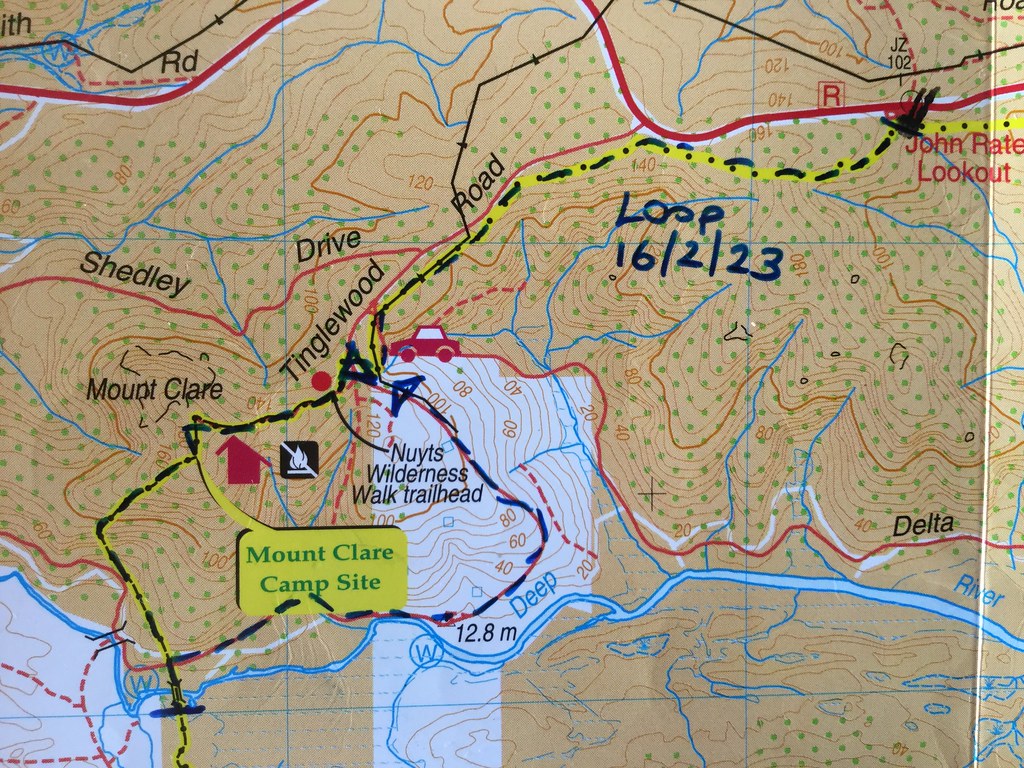
As we were exhausted from working a bit too hard, we set out without a particular walk target, just to enjoy the forest and possibly have our lunch at the Mt Clare hut.
Here’s a context map of this special part of the world. There are no roads south of the Deep River; it’s walk-only. That situation is a little analogous to the amazing South Cape Bay Walk in Tasmania, where the road ends at Cockle Creek and from there you hike to the ocean – in that case, to the southernmost point of Tasmania.
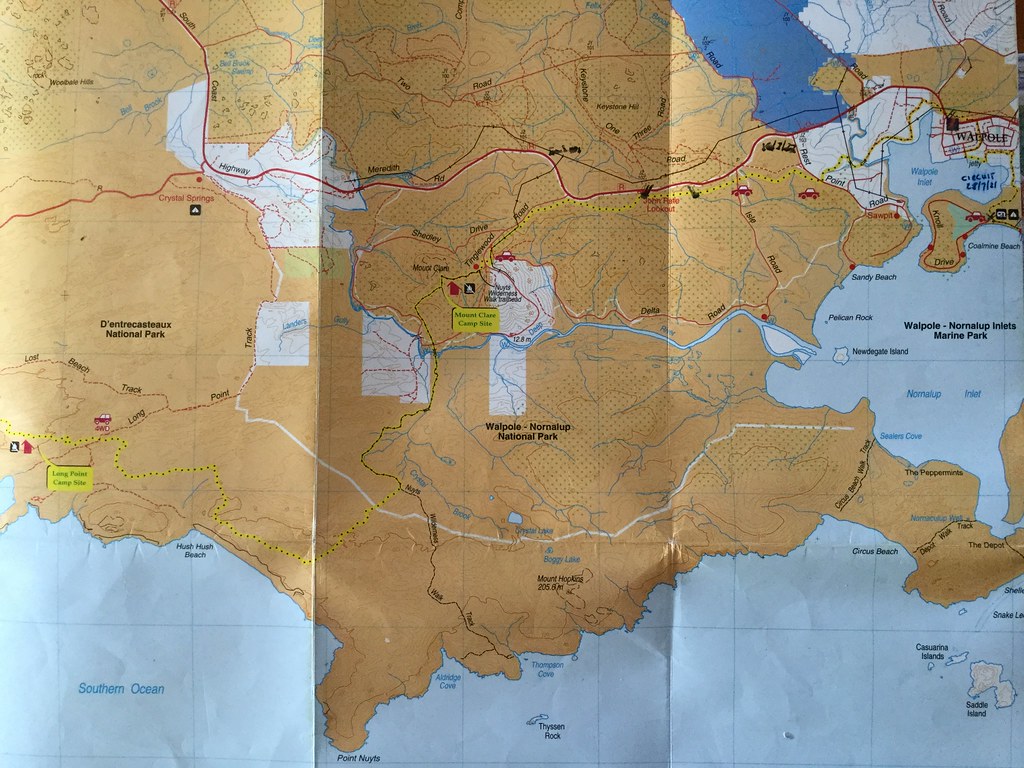
There are sadly so few areas left in the world like this. We are such a terribly destructive culture. 250 years ago Australia was still unmarred by European civilisation and its large-scale annihilation of native ecosystems and cultures. Many people don’t think it’s even a problem. It’s not helped by the fact that Australia, like the US, has a highly urbanised population. Most Westerners essentially grow up in captivity and have little exposure to or understanding of natural ecosystems. I met kids in socially disadvantaged parts of London who had never seen a tree that hadn’t been planted by humans, and who didn’t even have an interest in such things. I went on a bush camp with privileged high schoolers from Sydney’s Northern Beaches who screamed when they saw insects and who immediately got out their pocket wet wipes when they got a bit of mud on their legs when we went hiking. They were ecstatic to get back to the shopping complexes that were their natural habitat. People can live and die entirely swallowed up in dystopia, so far from their roots as biological beings that they may as well live on a space station.
This is at the start of our walk at John Rate Lookout.
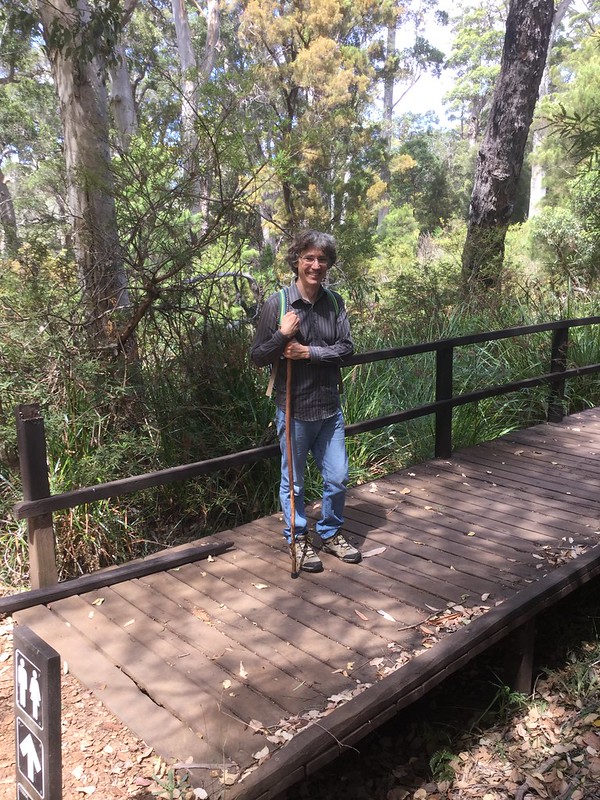
And we shall be your Hobbity guides today, so that if you live far across the seas, you can have a vicarious experience of this ancient ecosystem, which I shall do my level best to make vivid for you through photos and prose, so that hopefully you will be able to feel that part of you went walking with us.♥
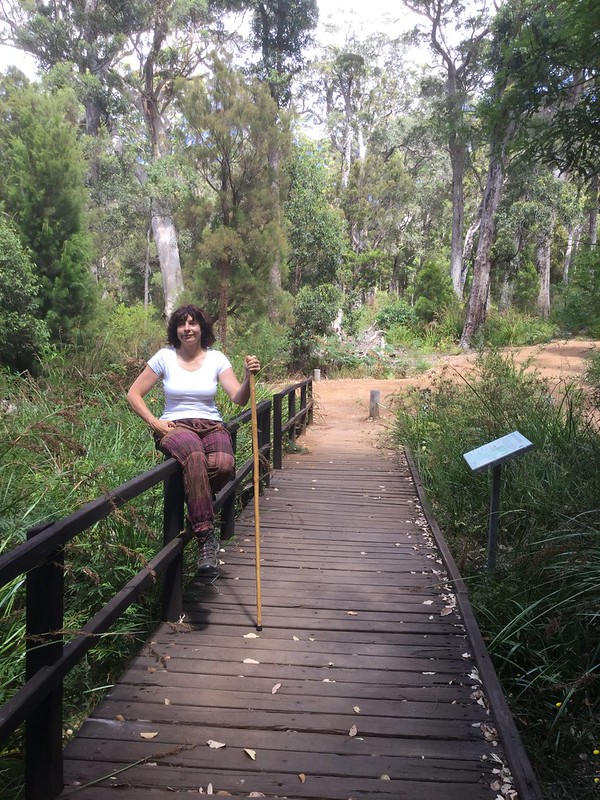
There’s a boardwalk at the lookout with steps leading to the Bibbulmun track and a sign suggesting people walk into Walpole. We were heading in the other direction.

John Rate, perhaps unwittingly part of the machine that pulled down the Old Growth Forests, got a mention on this sign but I bet his much-feted understanding couldn’t have held a candle to the ecological understanding of the Noongar people who used to live in this forest. He’s celebrated for “discovering” a species of Tingle tree, as Captain Cook was celebrated for “discovering” Australia. It’s an odd way of looking at Australian history, to imagine people could have lived here for 60,000 years ignorant of this tree or of the continent beneath their feet.
You have to read the tourist information signs in the forest areas with a large grain of salt. It’s better to get into the forest and let it inform you.
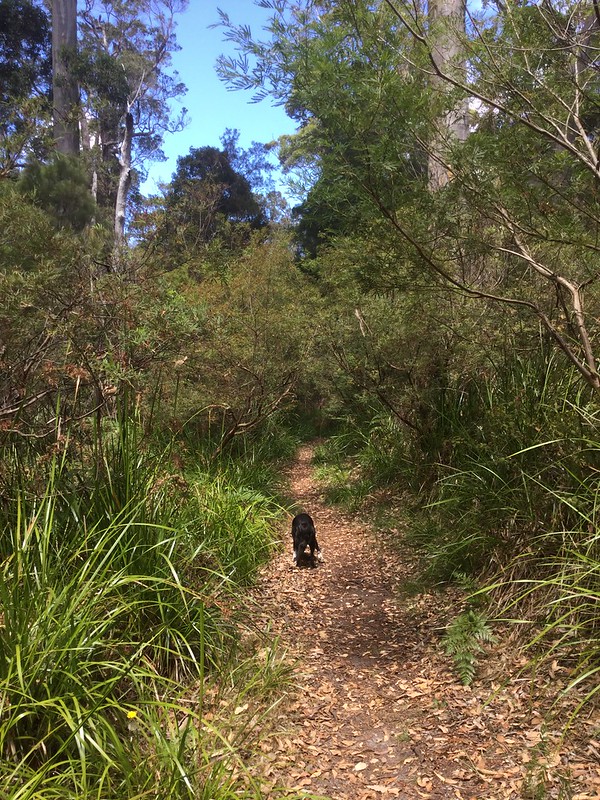
Brett and I are so aware that urban and agricultural landscapes are terribly scarred and ecologically degraded, even the ones considered picturesque. It’s funny how the Western euphemism for degradation is “development” – I laughed when I heard a story about an Indigenous man from a rainforest saying, “What do you mean you want to develop this forest? It’s already developed – it took millions of years to get to this point!”

We treasure being able to immerse ourselves in relatively unspoilt areas, and to listen, with our bodies, minds and hearts, to what nature is saying to us. This is like coming home, on a fundamental level. It is like visiting a living cathedral, and learning about the respect and kinship you are supposed to have with the web of life. It is learning your place, which is as one species among many, and not as the alleged cream of creation, nor as the self-proclaimed pinnacle of evolution. It is learning about yourself as a biological being, walking for hours as your ancestors did on the African plains, down from the trees with hairless skin to help with evaporative cooling.

I’d not felt that energetic when I woke up that morning, and we had considered shorter walks even than the open-ended “John Rate Lookout to maybe Mt Clare hut if we can make it that far.” Yet we ended up walking for hours without committing to that in the first place, just because it was so magnificent to be in this forest.

Hollow spaces, nooks and crannies everywhere. The whole place teeming with life, despite the fact that we’ve tried to crush life out of these forests, and have significantly succeeded in doing so. I’d love to travel back in time 250 years and stand in this place, before this country took the dubious honour of having the worst rate of mammal extinctions in the world and people bulldozed entire ecosystems off the face of the earth.

One of the things nature teaches is that we’re all both eating, and becoming food for others in turn. The feathers of this Port Lincoln Ringneck Parrot were left behind after it became a meal for another creature. When its body has been through and partly become that creature, the expelled remains become food for decomposers and nutrition for plant roots. We are stardust and we go around and around to make this glorious diversity of life on earth with each other. Or at least we are supposed to.
Civilised humans on the other hand like to be at the end of every food chain, taking and taking, eating everything and never giving back, not even after death, when our bodies are nowadays typically either burnt to a cinder with the help of fossil fuels, or entombed in a box of furniture-grade wood (from the body of a tree) six feet under and far out of the reach of the soil organic layer where decomposition occurs and feeds a plethora of species including, finally, plants – but oh no, why should we give back? Why should we admit we’re part of all of this when we can pretend to be above it – above the web of life which birthed us? When we can make believe we are some superior being only owed and never owing, not a mere part of the biosphere but its appointed master and annihilator?
A song about world views…
It really is insane, all this crazy desperate need
For unknowable magic, strange supernatural power
You’re flying through space at a million miles an hour
For 4 billion years, the sun keeps coming up
It’s all too wonderful for words but for you it’s not enough
You should step out of the shadows yeah and step into the light
All too wonderful for words, but precious few in Western culture who truly see it and who deeply care for it. The astronomical things sketched in the song, or the beauty and intricacy of the biosphere – which for our society is primarily a resource to be exploited, not Life to be honoured. Your life is cheap, if you’re an ordinary citizen, as many have found out and are continuing to find out when push comes to shove; and it’s even cheaper if you’re some other being, especially if you’re not “cute” (i.e. big-eyed and rounded and resembling the human infant), or if you’re as visually and behaviourally different to Homo allegedly sapiens as a tree or a slime mould. To The Economy, you’re just a commodity, valued according to the money you can make someone else. It’s The Economy, stupid. There is no community – not a human community, not a biotic community – these things don’t matter, when push comes to shove; the best they get from the power structures of our society is lip service, pretence and equivocation.
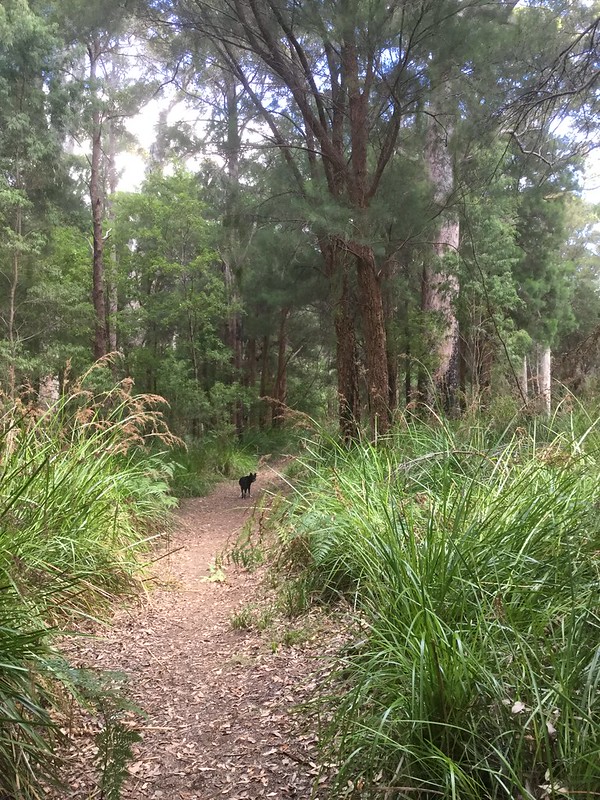
From the time I was a young child and first disappeared into the wooded foothills of the Italian Alps with only a four-legged canine companion in the late 1970s, I felt embraced by the natural world, safe, welcome; and I felt an ever-increasing awe and love for it as I got to know it better. When I was an adolescent, I began to look through the microscope of biology, ecology, physiology, biochemistry, physics etc at the natural world, like Gulliver’s Travels to Brobdingnag where he was suddenly tiny and could see the world in much more detail than ever before; like a Fantastic Voyage into the bloodstream of the biosphere. My awe and love for the natural world continued to grow.
I still feel this embrace, and my inner response to it, every time I go out to where nature is still writ large and still breathing. From the time I was a child, I’ve touched branches and reeds on the sides of trails with affection, loved the aroma of leaves and flowers and of earth after rain (for which we can thank the actinomycetes), and liked to feel raindrops on my skin. I’ve delighted in the presence of ants, bees, dragonflies, ladybirds, butterflies, scrolly-antennaed moths, chirpy crickets, praying mantises. And that’s just some of the insects…if I were to enumerate other sources of delight in nature, I could fill volumes (and I have).
So let’s turn our attention to some of the special trees on this hike. Close to Walpole there are three species of Eucalyptus referred to as Tingles, which grow into veritable giants, especially in girth. Over the hundreds of years, a lot of them get their bases carved out by fire, which is a normal feature of sclerophyll vegetation such as we steward at Red Moon Sanctuary, and also, at longer intervals, of the eucalyptus forests in the higher-rainfall areas towards Walpole. Indigenous Australians prevented major wildfires with mostly cool-burning cultural burning practices, at the right times to reduce risk and encourage biodiversity, such as the plants and the animals they depended on for food. In a summer-dry ecosystem where microbial decomposition activity is seriously inhibited, the right fire at the right time (generally small-scale, cool, and near the start of reliable rains) can be a helpful tool for turning dry dead plant material into nutrient-rich ash, which gives a boost to soils, promotes new growth in plants and allows for spectacular flowering. It also gives a good start to the seedlings that have the space and light to grow when dry dead material is converted to ash. Good plant growth and flowering in turn benefits grazing and nectar-feeding animals.
Another benefit of fire is that it tends to create shelter and nesting hollows in the older trees and in fallen trunks, which benefit birds, mammals such a possums, insects, etc etc. In the bases of many old Tingle trees, these are more like caves!

The next photo has Brett standing in the base of the tree for scale.
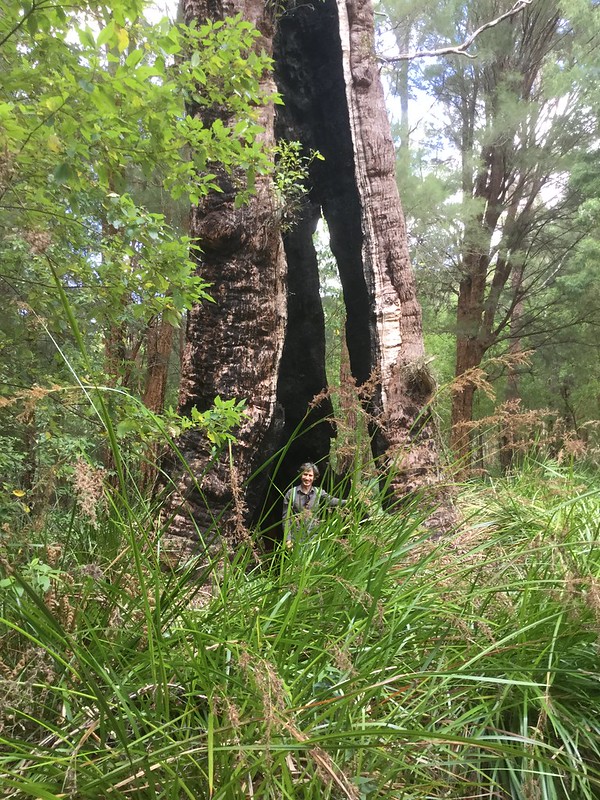
Now I’m zooming in, and you may see him better!

Now we’re looking up at the tree.

There is rather too much of it to get even half of it into frame. Since we actually didn’t know we were going to do a walk we’d not done before when we set out in the morning, we didn’t take the good camera that usually accompanies us for documentation. These snaps were taken on an iPod, which is a bit limited and produces a bit of distortion, most notably in people photos.
Next, Brett spotted a bright orange bracket fungus with an unusual shape.

It’s probably a Curry Punk (Piptoporus australiensis). The guide book says “edibility unknown” and that made me recall an answer I got when I was little and asked which fungi you could eat, and was told, “You can eat all fungi, but some of them only once.”

Since we knew people overseas or in cities would be interested, we took photos of quite a few different hollow Tingle-tree bases. (By the way, not all of them are hollow!)
So here’s another.

I went inside this tree but couldn’t look out of the “window”, it was too far up for me! So Brett photographed through it from the outside. The ground outside the tree is usually significantly higher than inside because the fire carves right down into the buttresses.

This was the view out. You can’t see it properly, but in the first one Brett pretended he’d been speared through the head with his walking stick. So I hereby dub this photograph “The Spearhead From Space“ (after an old Dr Who episode – my husband is a big fan).

This would be quite a nice place to overnight in if you brought a camping mattress and some mosquito veils. The base would easily accommodate a Queen-sized bed, not that you’d bring one of those. It also has great views.

This was the “door”…

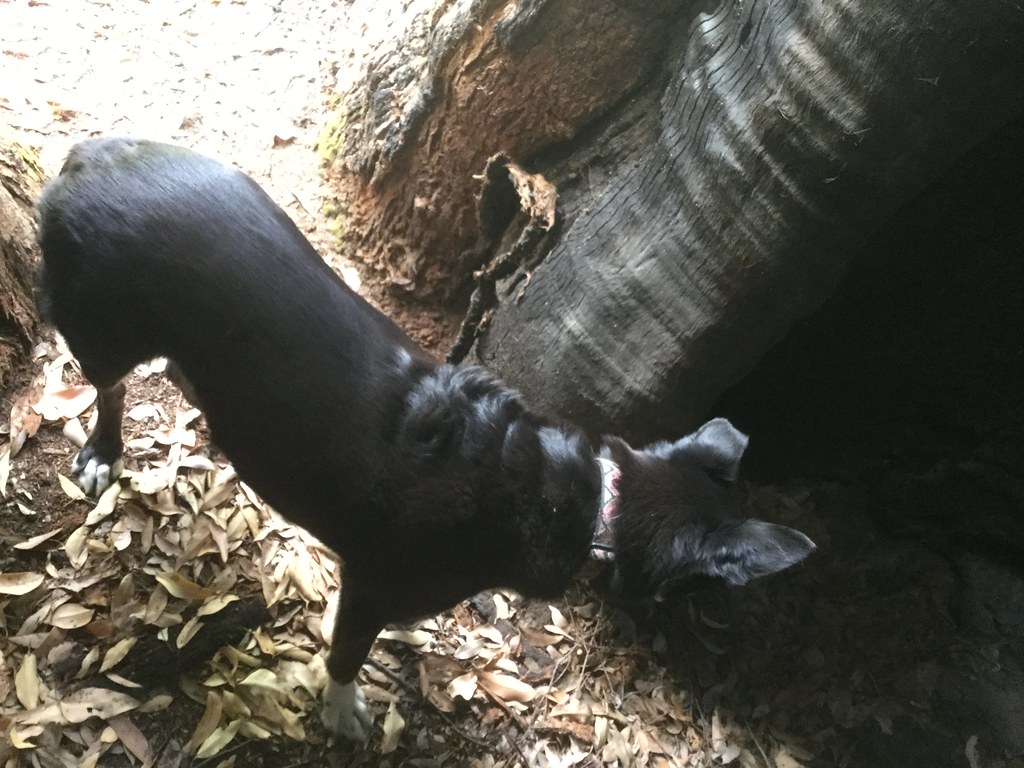
This was the roof, considerably above me.
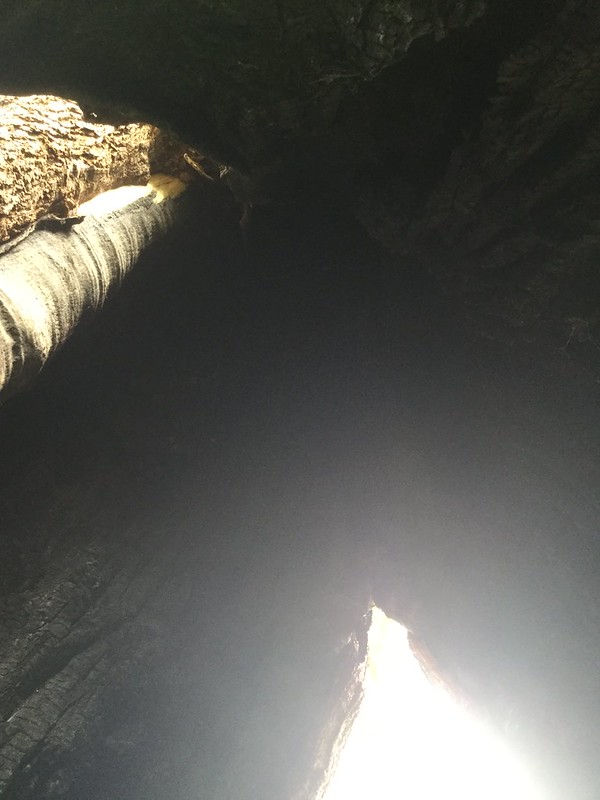
And this is another window.

We continued on our merry way. The temperature in the forest was most pleasant, even though we had been cooking already in the sunlight on the way there. The moment you step into this tall forest, you are mostly walking in shade or dappled sunlight; only occasionally there is a burst of full sun. This is how life makes conditions for nurturing more life; creates a wonderland of species and habitat and microclimates and even influences the weather.
And we Westerners chainsawed, logged and bulldozed most of these forests into oblivion, and much of what is left into a shadow of its former glory. This is one of the little patches in which old-growth trees can still be found. Most of South-Western Australia’s forests and woodlands were converted to farmland, where pastures and monoculture crops swelter under the sun in summer and exposed soils dry out and die. Because we think what we do is so superior to what the Indigenous people who lived here for 60,000 years did. And we won’t last 60,000 years, we’ve already destroyed much of Australia in under 250 – we’re a short-term thrill with chronic delusions, mostly about how clever and superior we are, and how our technology will save us.

This next photo, Brett was very adamant should be called ” The Moss-Tache”…

And then we were crossing Tingledale Drive, and arrived in the Nuyts Wilderness trailhead area, where there were lots of information signs.



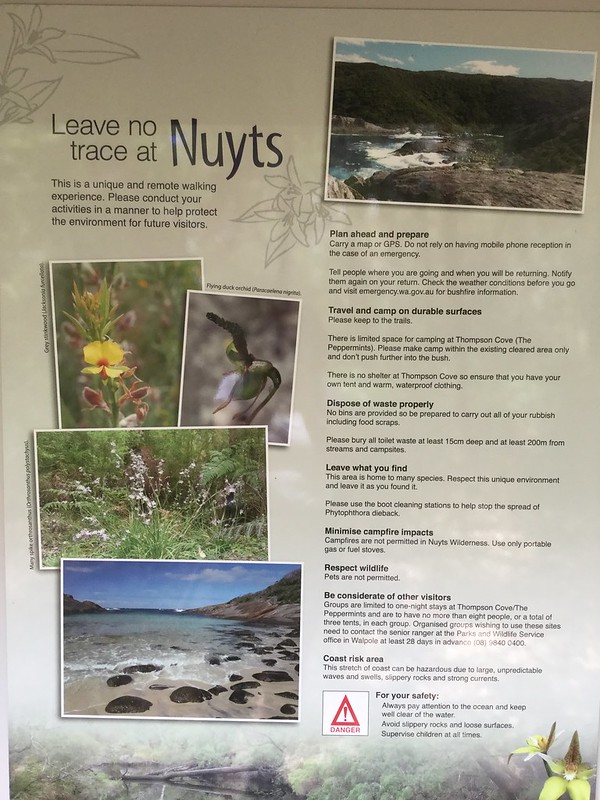
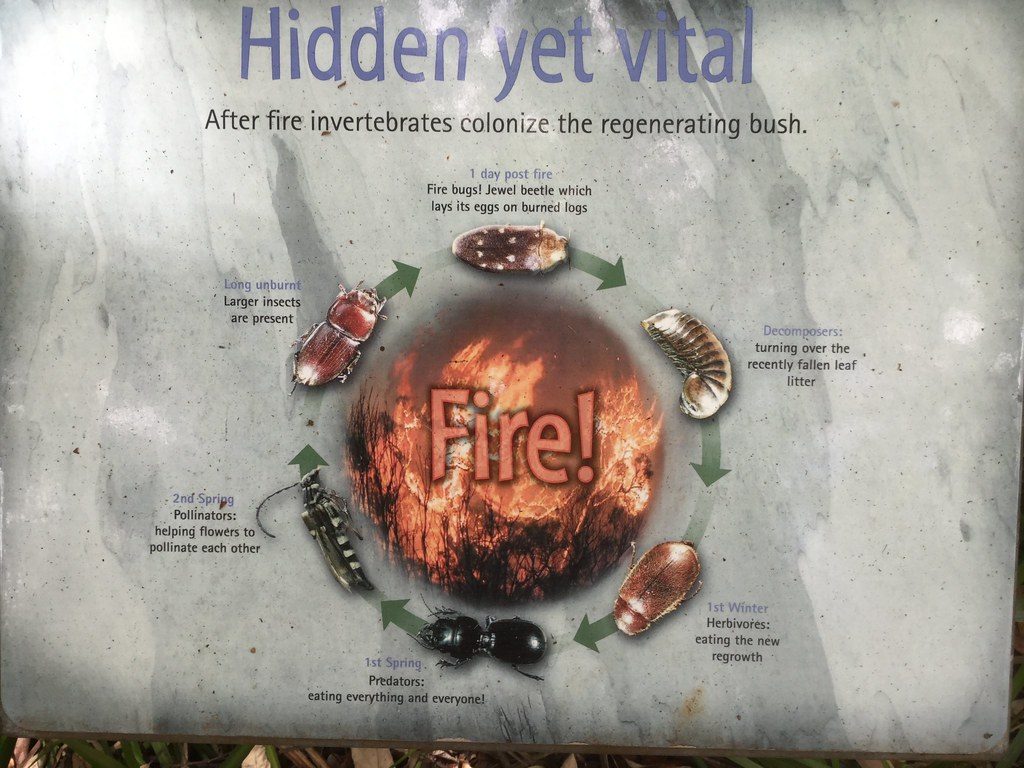
We continued up Mt Clare – at this point the Bibbulmun Track and the start of the Nuyts Wilderness Track overlap, as you can see on the context map at the start of this photoessay. The climb up was on a gentle slope.
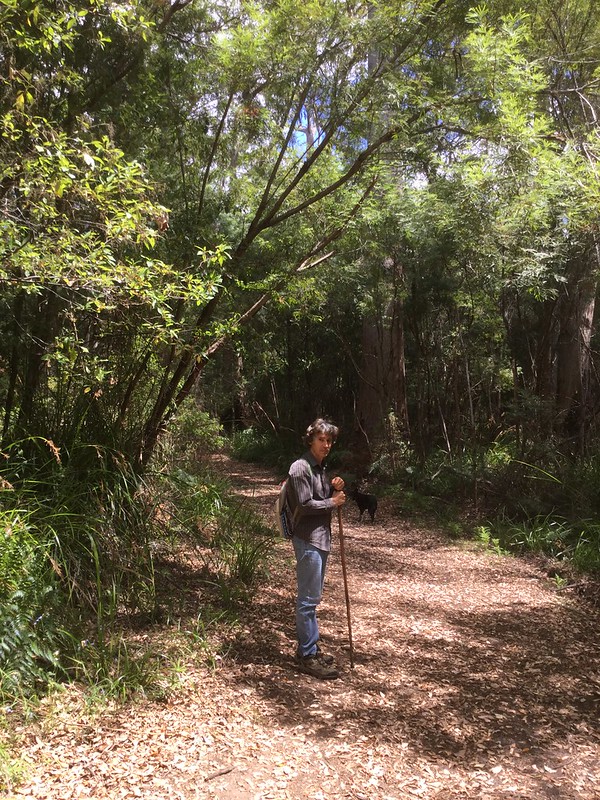
There were more information signs…

If you look closely behind the third Tingle in the background in the next photo you can just see the roof of the Mt Clare camping hut. You may have to look lower down than you are expecting as these trees are enormous…


Usually we stop and rest at these huts all along the Bibbulmun trail – they appear at approximately day walk intervals. However – and this was a first for us – the Mt Clare hut had been freshly repainted and reeked of industrial solvents, so we tried the open-air outdoors table instead. It too was most malodorous, as perplexing a phenomenon in such a near-pristine ecosystem as when you go mountain climbing with a chain smoker. So we checked our map and decided to have lunch at the gazetted suspension bridge across the Deep River, which sounded very interesting. We haven’t been across a suspension bridge on a hike since our half year in Launceston in 2009, where we were frequent hikers on the Cataract Gorge trails.
On the way there were some major tree hugging opportunities. Here’s a Tingle with a solid base.

An old-growth Tingle is not easy to hug. It’s a bit more like leaning in affectionately, but there’s no way the arms go anywhere near around even a fifth of the 12m circumference. Nevertheless, I think the intention is perceived in some way. These are ancient beings hundreds of years old. No wonder Tolkien wrote about Ents.
I don’t know how anybody can think cutting one of these down is fine and dandy, but in this world, every day, we are losing such trees to insane humans working in an insane economic system. I don’t know how anyone can think they make it right by “replanting” another tree. It would take hundreds of years to get to the same life stage, if it even lived that long – and natural forests plant themselves, thank you very much, and unlike plantations, are a treasure trove of genetic diversity and relationships. Humans only had to start planting trees after their own activities obliterated most of the trees on this Earth. We owe much more than we can ever repay, and it’s farcical to talk about carbon credits and biodiversity offsets. It’s a veneer of greenwash to conceal a core of ongoing and ever accelerating destruction, while people abuse words like “sustainable” and “love” and make “Centres of Excellence” for biological research which is never allowed to say no to profit and “progress”.

Here’s some upwards photos of the same tree! I got much of the trunk in the first one, but needed another to look at its crown in the canopy.
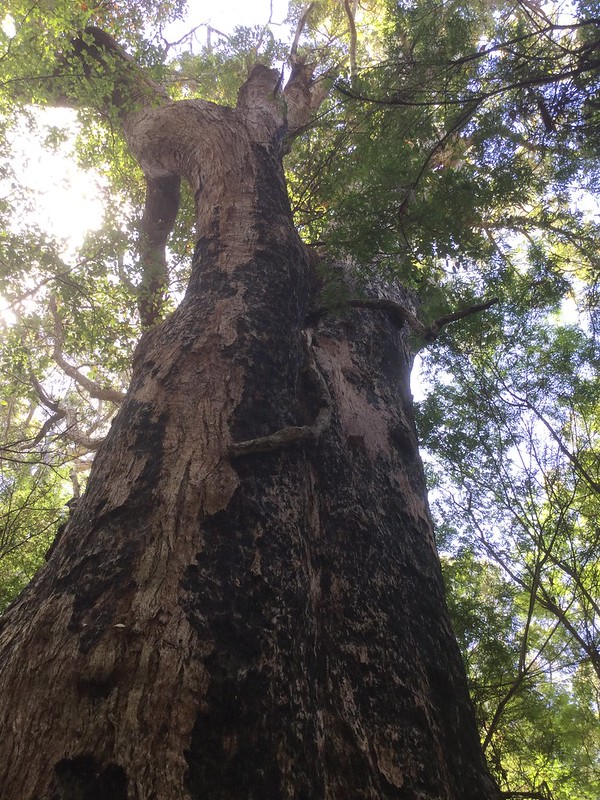

We had a kilometre to go until the Deep River; beautiful forest, and a fairly steep descent. As we approached the river valley, granite started peeping out of the ground.


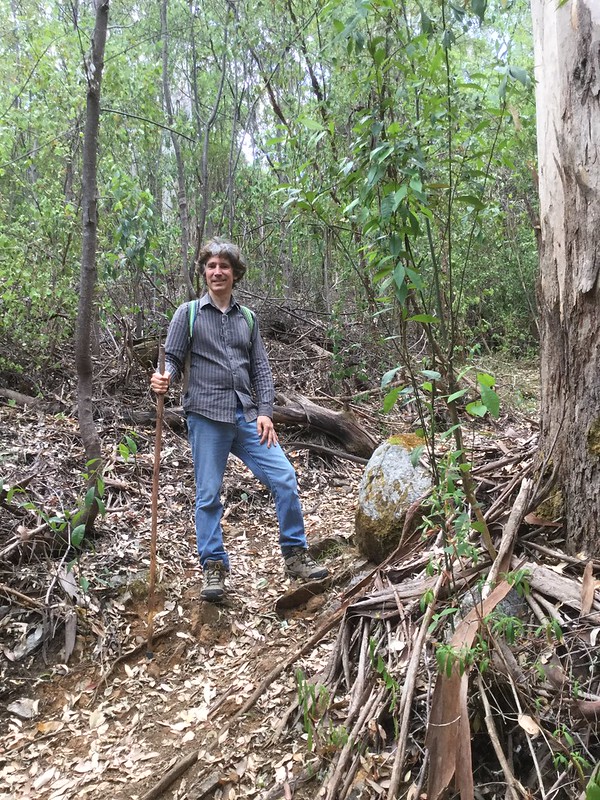
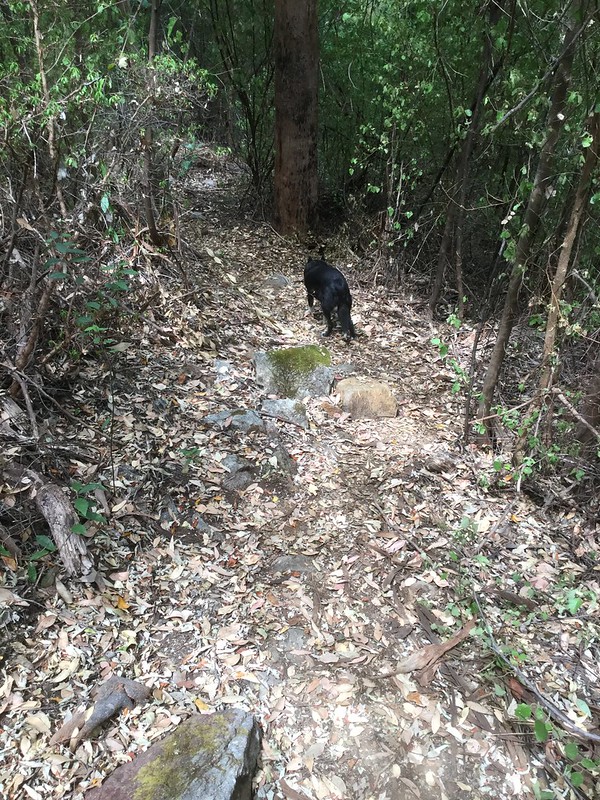
The photos visually flatten out the actual steepness – in the next photo, we were upslope and across a small tributary valley from the dog who was climbing the slope on the other side!
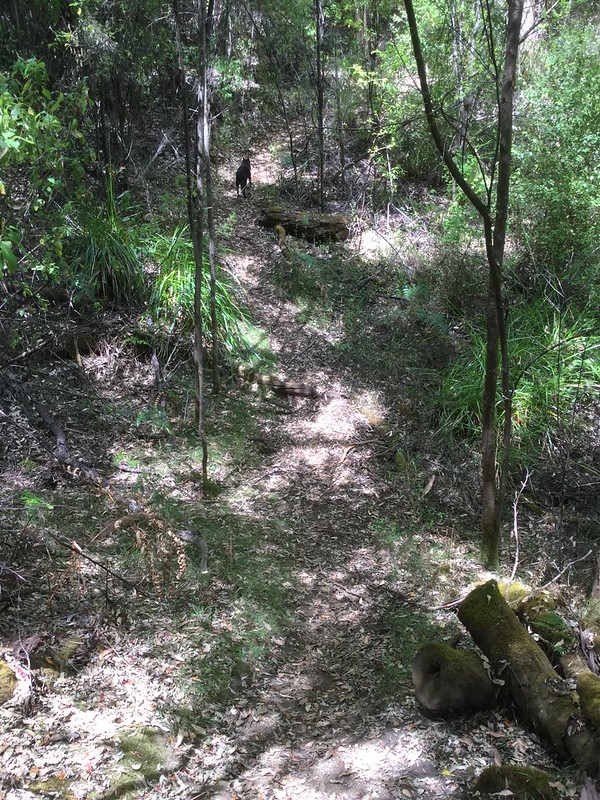
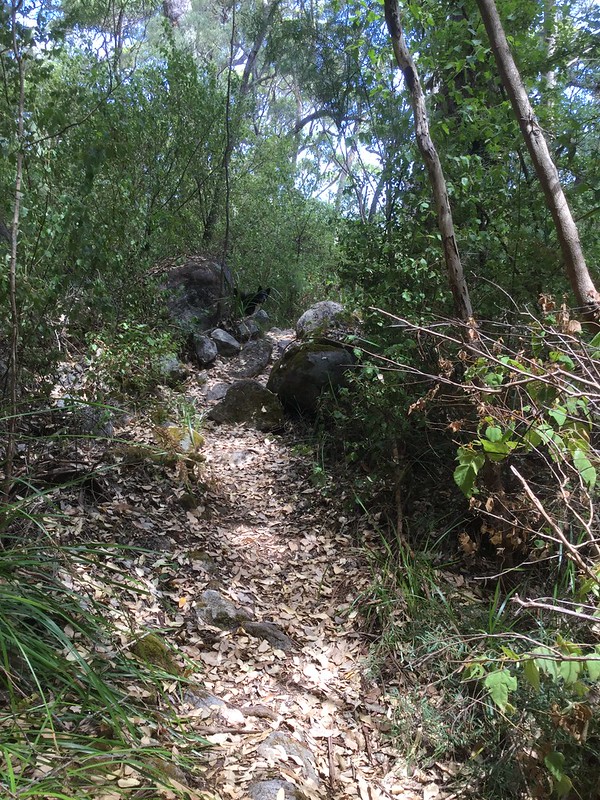
“C’mon, keep up!” – says the dog, looking back at us. She could smell the water and was keen for the promised swim. When I know we have definite swimming opportunities ahead, I tell her there is a “splish” coming up. Dogs find words easier if you use onomatopoeia. This is also why when we’re talking to her, a car (or car trip) is a “brroom-brroom!” and the mention of this word at home gets excited leaps from her and immediate attempts to herd us out of the front door. I should film it sometime.
Descending towards the Deep River, there were some majestic Karri trees. The binomial name for this one is Eucalyptus diversicolor, and you’ll understand why looking at its bark.




I actually love the fact that on the remote and serious trails, things aren’t constantly manicured and tidied up for the convenience of typical urban walkers. I like having to climb obstacles in places like this and to use my wits and my body to work out puzzles, instead of having a kind of pedestrian freeway presented to me, as is the case for the touristy spots like Bluff Knoll and the Granite Skywalk. I enjoy having to look closely at where I am going, and figuring things out. Not having such opportunities is just another way of dumbing down our world, our inner lives, and our physicality. I come properly alive in wild places. The animal I am recognises what gave birth to me, to us, long ago.
And then we were at the suspension bridge.
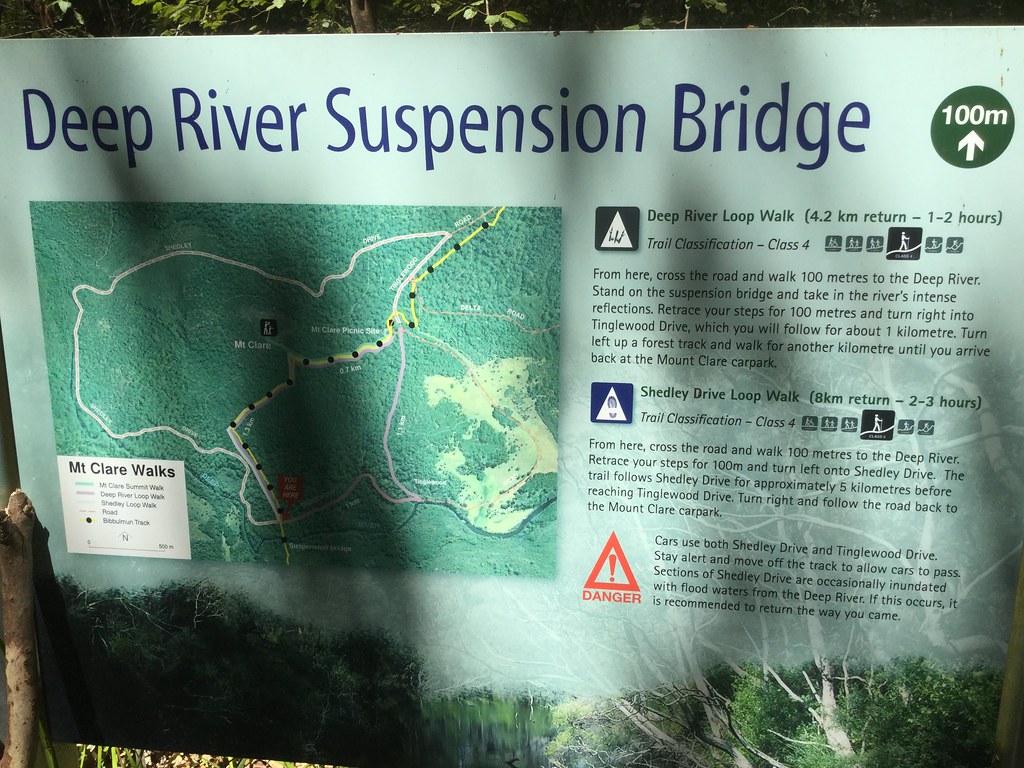



We stopped in the middle of this wobbly, free-swinging bridge to drink in the views of the Deep River. I took two photos, to the west and to the east, which you are about to see. But just before I took them, I asked Brett to please stop jumping up and down, because I was taking a picture. And he said, “I’m not jumping up and down!”
“Hahaha…sorry!” Long time no suspension bridge. (But it’s exactly the sort of thing my husband has been known to do…not to deliberately interfere with photography, but just for the joy of it…♥)
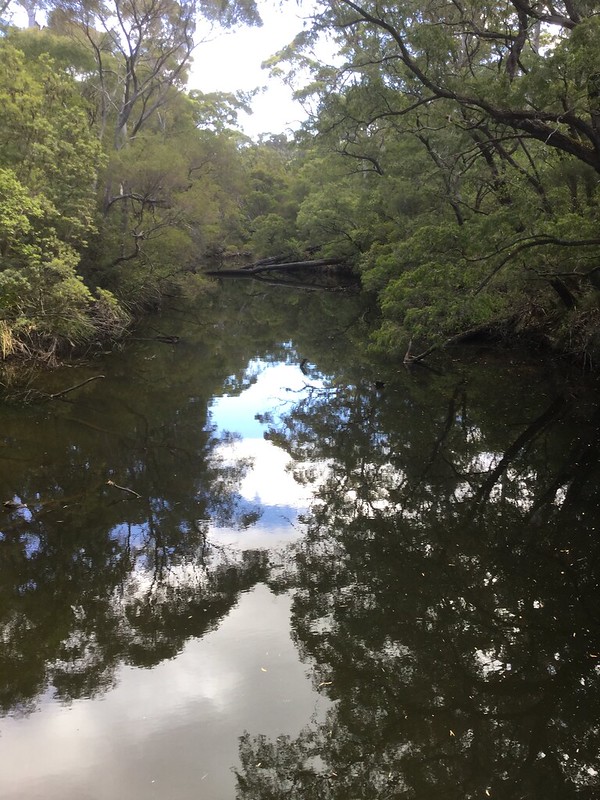

And once arrived at the other side, our delighted dog cooled herself down in the Deep River.♥ We’d been giving her intermittent drinks from a bottle we take especially for her – in summer, there’s not much water in this landscape. Jess is nearly 11 now and needs extra TLC, plus a sofa recovery day after a long hike, but so far she is still coping well with extended walking and would be outraged to be left behind when we do something so fun. In her prime she used to run rings around my endurance horse, or our mountain bikes, and cover at least twice the distance we did; plus she swam like a hydrofoil as a young dog. I actually think it’s kinder to an animal to put it down when it gets to the point it can’t do the things it enjoys the most anymore, and not let it linger. We’re not at that point and right now she’s on excellent arthritis treatment that re-lubricates the joints. She also these days really enjoys her sofa recovery days, combined with good grub, which allow her body to rest and repair. In a way, we’re a bit like that ourselves these days.
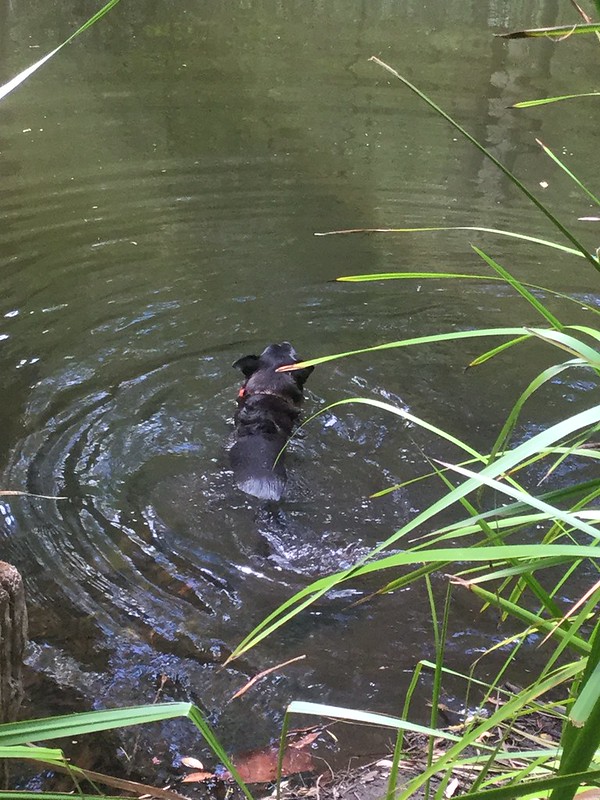





Fabulous dog.♥

We lunched on the steps of the bridge, in the shade, with a breeze blowing on us and the water flowing by. Brett had made us our favourite hiking salad: Just cut carrots and cheddar cheese into cubes, mix in a roughly 3:1 ratio, dress with lemon juice and cayenne pepper. Even the dog likes it. We also had salt and vinegar peanuts, half a home-grown Cox’s Orange Pippin apple each, and water from the drink bottles, mine with a splash of lemon.

Morning tea en route to Walpole had been ice cream made by the Meadery – double coffee for him; hazelnut on top, chocolate on the bottom for me. Normally we do that after a hike, but today we put it in the tank first. Waiting at home to balance us up in the evening was a big dish of moussaka, with home-grown zucchini, potatoes, tomatoes, herbs; kangaroo mince from Woolies (we’re currently out of home-grown beef mince), cheese sauce on the top potato layer, tons of grated pepper.
Kangaroo is equivalent to venison; the top predators were largely removed on the respective continents and neither the common deer species or the Western Grey Kangaroo are endangered, but the landscape has to be protected from overgrazing (and not just by kangaroos) or we’re going to accelerate bird and small mammal extinctions, not to mention flora, insects etc. We’re happy to co-graze wild kangaroos and emus with the cattle and equines on the pasture/permie previously cleared fraction of our place and don’t deter them; we welcome their presence and, excepting for our vegetable garden, deliberately made the fence passable to them but not to the livestock. (Top and bottom polybraids in the internal fences are hot but the middle is not, so they can slip through without getting zapped. Also, for boundary fences, have you heard of kangaroo gates?)
Occasionally local Noongar people will take a roo for their traditional food from the healthy local populations, including from Red Moon Sanctuary; and we eat the odd one that gets put down due to injuries like broken bones. A local octogenarian bushie friend who died last year brought us the occasional fresh roadkill he found by the highway; Trowunna Wildlife Sanctuary in Tasmania does the same to feed their charges. We don’t have Tasmanian Devils, but we do have a dog and stomachs of our own and these carcasses need taking off the roads. It’s not for everyone, but we’re fine with it if it’s fresh (and Jess prefers it when it’s not, and will track down her own). If you grew up in the city you may be appalled, but we didn’t and we do live close to the cycle of life and its realities. Also I’m a very good cook, and we’re both foodies – so don’t imagine that there are taste or food safety compromises.

Alas, the food that nurtures, repairs and powers us, and the acceptance that we should give ourselves in turn to the nurture, repair and powering of other beings when our lives end, instead of locking ourselves away like misers when we’re dead. Hat firmly off to Indigenous Australian traditional burials, and the sky burials in the Himalayas, and any other culture who recognises that we are part of the circle and need to act and live like it.
And then we were homeward bound again, for variety taking the loop route via Tingledale Drive back to the Bibbulmun (see map at start).
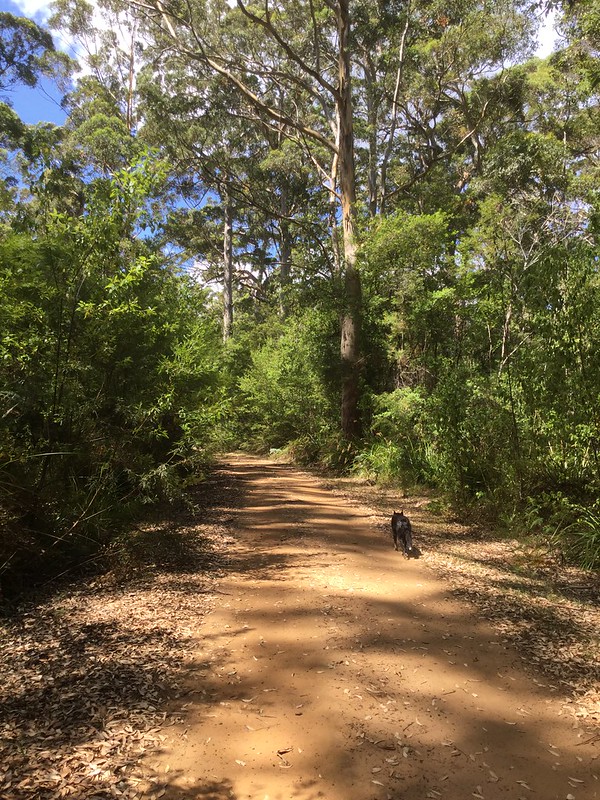
There were more Tingles with hollowed-out bases whose cubbies I tried out.
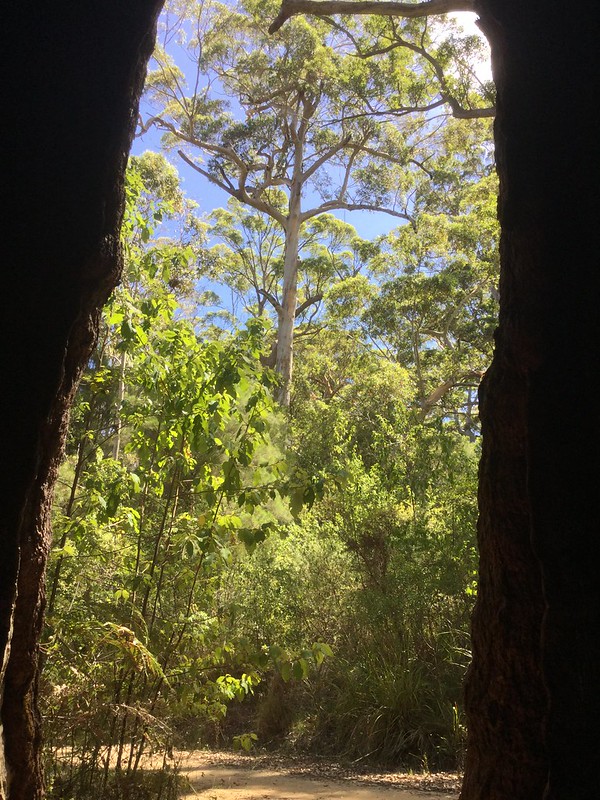
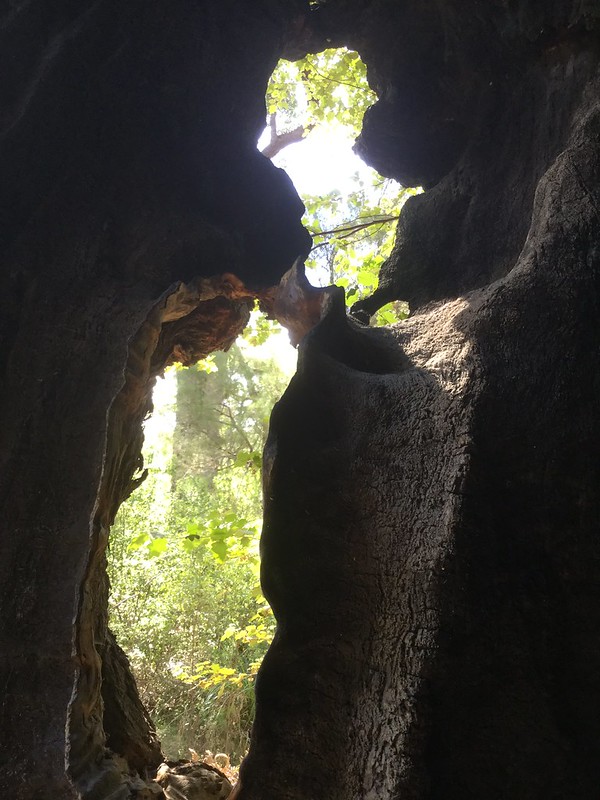
There was an agricultural clearing in this valley with something that looked like an outdoor education camp.

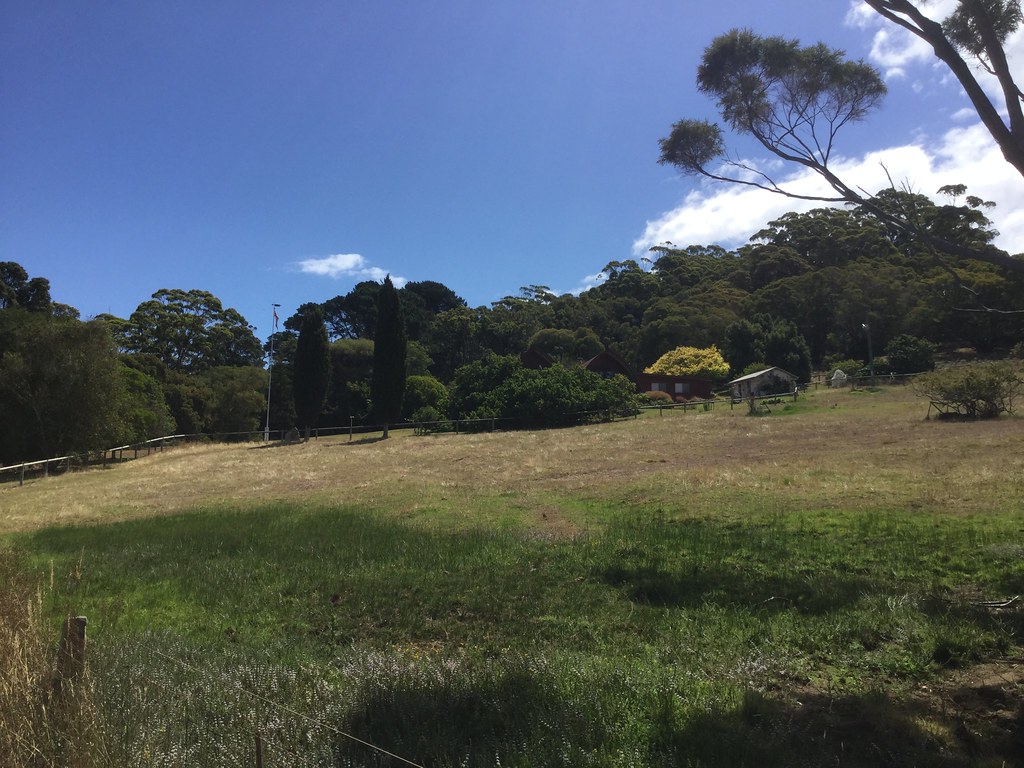


It was really hot on the road – removing a forest will change the microclimate. Local cattle were looking to rest under shade trees. Many of the big-business paddocks near where we live haven’t got a single tree in them and it should be illegal to keep animals in shadeless pastures – but the big corporations have got into the beef game and are making their own rules, which are all about maximising profit and pushing family farmers out of business. It’s expensive and time-consuming to plant shelter belts as we did, and you won’t break even financially on them through increased livestock productivity – we do it because it’s the right thing for umpteen reasons including livestock welfare, biodiversity conservation, soil conservation, the water cycle, water quality in rivers/estuaries etc, but having worked as an environmental scientist and seen how this goes, I don’t expect environmental and animal welfare issues to be given more than lip service and occasional window dressing projects by our powers that be. Money and greed drive basically everything in our culture, and big business is good at obfuscating and at finding scapegoats for a largely ignorant public to swallow.
Glory be, in this non-corporate little valley someone was deliberately planting Peppermint trees by the roadside for shade. You can see them in this view back towards the south-east. We have planted clumps of them too; a decade later they become enormous and make welcome shelter areas for birds, insects and domestic pasture inhabitants.
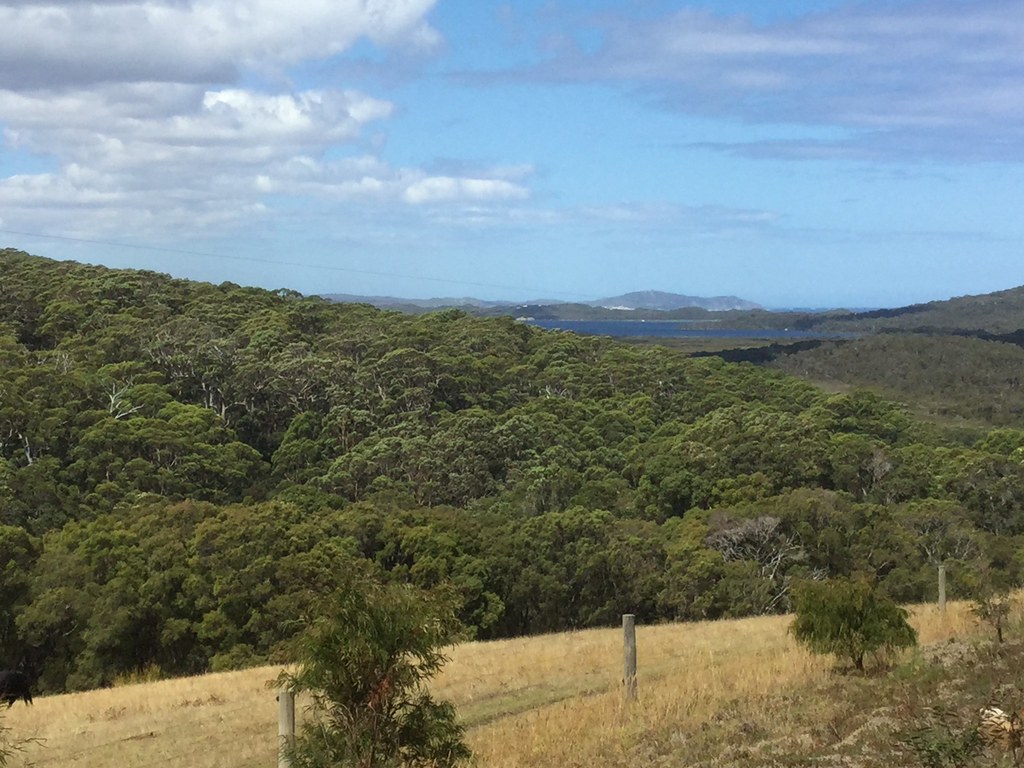
Mature shade trees are very popular things…

We rather felt like lying down under one of these trees ourselves, at this point. There is a world of difference between spending a summer midday in a tall forest, or walking on a road through a clearing. And to be honest, our feet were beginning to hurt after several hours of serious hiking that hadn’t strictly been on the agenda when we woke up – and it’s not as much fun to hike on vehicle tracks than twisty-turny walk trails.

Occasionally, remnant roadside trees provided a bit of shade. We were very happy to get to the Bibbulmun track intersection and back into the proper forest, where Brett was keen to pose for a photo.
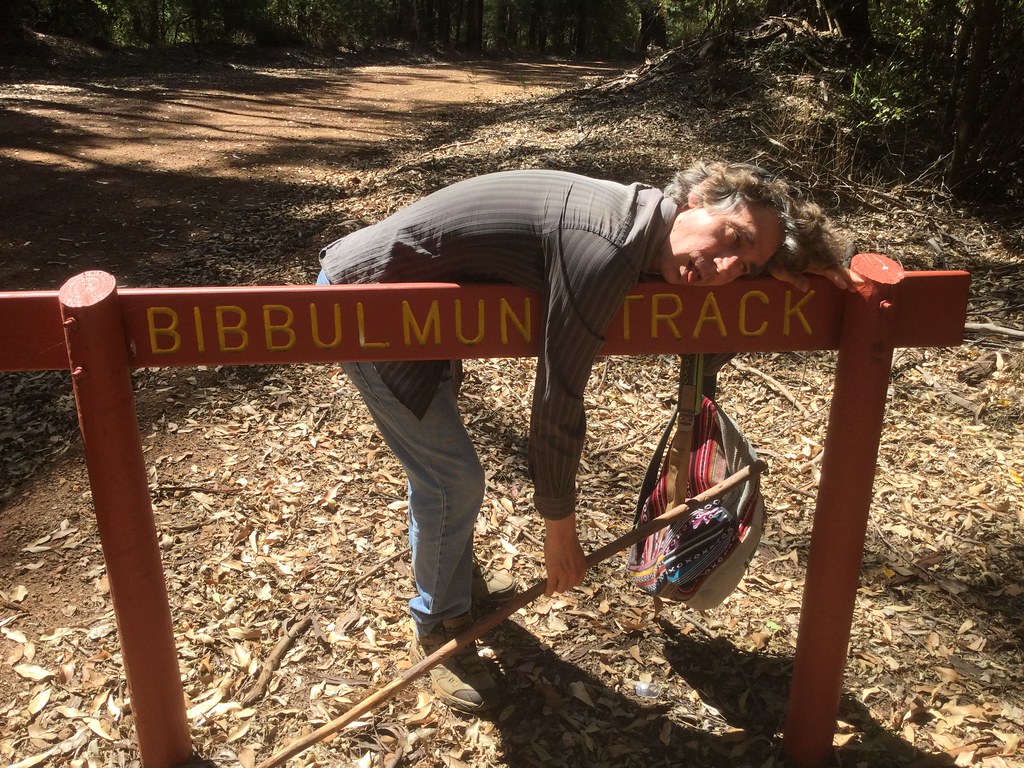
He is such a drama queen. I’ve got a very similar photo of him at the tail end of our 8-hour loop climbing Cradle Mountain and returning via the Twisted Lakes, from years and years ago…

We were very happy to be out of the sun again.

Fallen forest trees make such great habitat opportunities…and it’s so annoying when ignorant people take their chainsaws and 4WDs into forests to “tidy up” and get a trailer load of firewood, thinking they’ve done some kind of community service when they’ve actually made wildlife homeless. This is where we are at – with a largely ecologically ignorant population of zoo humans thinking like this, about this and hundreds of other situations involving other species. Where do you even begin, and what hope if it conflicts with their existing world views, which are so precious to many and almost written in stone? That’s adult…it was a lot better working with adolescents, who were more open-minded and willing to look critically at the everyday and “normal” than their alleged elders and betters, than it is to try to have discussions like this with adults who have shut shop.
Thankfully I also know adults who haven’t shut shop, and continue to learn and to modify their working hypotheses; and they love the natural world. Those are my tribe, and it’s a small tribe, possibly endangered, but much loved and appreciated!♥

And that’s all the photos! We got back to John Rate Lookout, where we immediately took off our hiking boots to air our hot and tired feet, and drove home barefoot, listening to mostly acoustic music and chatting about this and that while fantasising about large cups of tea and bed rest. What an excellent day – and such an unexpected long adventure on a completely new-to-us trail! I couldn’t sleep for ages that night due to all the metaphorical champagne bubbles fizzing around inside of me. A day like this makes up for so many days of toil and staying home, for living on a smallholding in the middle of nowhere and no longer travelling much in the world. A day of wonder where you see and embrace wild nature, and she sees and embraces you.
♥ ♥ ♥
All the photos in this piece were taken by Sue Coulstock and Brett Coulstock.
Featured image: A numbat by The Last Stand via Flickr(CC BY-NC 2.0)

by DGR News Service | Mar 20, 2023 | ANALYSIS, Culture of Resistance, The Problem: Civilization
Editor’s Note: Today we’re sharing the following brief essays written by members of Deep Green Resistance:
My Favorite Natural Place
When I was about 8 I lived in the mountains and our home was surrounded by tall needly trees.
Not too far from one corner of the home, just slightly down the hill, was a small cluster of boulders. The rocks were situated in such a way that I could just manage to nestle myself 8-year-old self between them.
It was a tiny haven. A mini open-air dwelling and escape from regular life.
The chipmunks would occasionally join me and there we’d sit listening to the trees creaking in the wind.
I haven’t lived in the woods or any place even remotely as wild since. I’ve called cities home for the majority of my life, both before and after that time. And for an embarrassingly long time, I didn’t realize anything was missing from my life.
But somehow I finally realized the errors in my ways. There wasn’t any specific moment in time or place I visited that reminded of what I was missing. But I began to seek out natural refuges wherever I was. And when I took the time to look around me, I saw that beautiful places were everywhere. Not just in the mountains but in the city parks. And at the beach. On the trails near my home. Even my backyard.
If I had to pick just one favorite place in nature anywhere, I think the mountains will always top the list. But actually I like to think that wherever in nature I happen to be is my favorite place.
Why Should We Care About the Planet?
Two thirds of the oxygen in the air we breathe comes from plankton in the ocean. We evolved with nature, shaped by our relationships with the plants and animals around us.
Every cell in our bodies comes from nature. We are made of water, plant and animal, virus and microbe. The bacteria in our gut outnumber our own cells. We are human only in relationship with the more than human world. And it is an honour to be related. To share a connection with the magnificence and intelligence embodied in the diversity of species who are our kin. It is an honour to be an animal on this planet.
I care because I am in love with the natural world. And knowing what I know, I think it is a necessity to protect it. But more than that, it is an act of gratitude. The Earth gives us our very lives. It gives us the most beautiful things we will ever experience. I could work my whole life in activism and never repay the cost of a single breath of ocean air.
How Do We Prepare For What’s Ahead?
We are living in unpredictable times. Whether it’s the threat of nuclear annihilation, economic depression, or ecological collapse, no one can predict exactly what will happen or when. What we do know is that cities and suburbs will not be places humans can live in the long run.
Women need to learn self-defence now. As things become increasingly chaotic, men will look for an outlet for their violence. Those outlets are always women and nature. We can attempt to learn the skills that are necessary for survival in traditional human cultures.
But there are no personal solutions to social problems, which means we need to build communities, we need to organize, and we need to defend the natural world as if our lives depend on it, because they do.
A Culture of Resistance
What does it mean to have a culture of resistance? What does this culture value? What is it resisting, and why? How is it different from the dominant culture?
The culture that we are living in now — a capitalist, industrial society — has certain values that we have been told are important for our well-being. Some of these values are: unlimited growth is good, we can have whatever we want, humans are superior to all other life forms on earth, we can tame the natural world for our own purposes, and the individual is more important than the community.
The problem with these values is that they are unjust and unsustainable. We aren’t living within the natural limits of our planet. We think we can continue to use up everything on the earth, and there will be no consequences. And if there is a problem, technology will solve it.
In the meantime, the population continues to rise, more and more of the earth is being destroyed, and more species are dying every day. People are becoming more alienated from each other. They don’t understand, or don’t want to acknowledge, that industrial civilization is the cause of all this suffering.
A culture of resistance rejects industrial, capitalist values. It fights for the natural world and knows that we are just one of many species that share this earth.
A culture of resistance joins together as a community, and rejects the idea of individualism. No one person is more important than another. We work together to meet our needs. We respect all beings and realize that we are dependent on nature to live. Nobody should be using up all the natural resources, thereby making it very difficult for others — human and nonhuman — to survive. It reminds me of the Buddhist teaching, “Do not take anything that is not freely given.”
A culture of resistance recognizes that the earth is finite. The planet can support a few million people, but not billions. It can provide us with all we need to stay alive and healthy: clean water and air, natural food, and adequate shelter. Other beings on the planet are respected and seen as part of the natural community, not things to be exploited. Hunter-gatherers used to live in harmony with nature for thousands of years, and it was sustainable.
The modern culture we live in today is toxic in so many ways. If we do not resist, it will continue to grow until it collapses under its own weight, causing unimaginable destruction and suffering. We must get rid of industrial civilization. Join the culture of resistance!
Why I Joined Deep Green Resistance
By Iona
When I came across Deep Green Resistance I had no background in environmentalism and no knowledge about the ecological crises our planet was facing, and in many ways I felt like this put me at a disadvantage. But I think it gave me one really important advantage: it meant that I hadn’t yet been taken in by many of the false solutions offered by the mainstream environmental movement.
I hadn’t been primed to believe that my power as an activist was limited to petitions, street protests, reducing my carbon footprint and so on. And it meant that I didn’t already have a strong belief that technologies like wind and solar were solutions for the planet. It quickly became clear to me, through understanding this new analysis, that such technologies can only be seen as solutions in a world in which humans have lost their true connection to the natural world.
I learned that some studies have shown that renewables are expected to be the number one cause of habitat destruction in coming years. So that begs the question, is that what the planet needs? Is that something I can stand by and support?
My hope is that more people start to question some of these mainstream narratives, whether or not they already understand what’s happening to our planet — our home.
I want more people to look at the facts, and be unafraid in making up their own minds how they feel about what they see.
I want more people to feel confident in questioning whether a new form of industry that calls itself “green” is what the planet really needs, whether it’s really what we want to be doing to our home. And whether we think this industrial way of life we’ve all become so used to is really sustainable.

by DGR News Service | Mar 17, 2023 | ANALYSIS, Biodiversity & Habitat Destruction, Mining & Drilling
Editor’s Note: Taking the context of Maryland’s forests, the following piece analyses how the mainstream environmental movement and pro-industry management actors have used deliberately misinterpreting to outright creation of information to justify commercial activities at the expense of forests. Industrial deforestation is harmful for the forests and the planet. The fact that this obvious piece of information should even be stated to educated adults affirms the successful (and deceitful) framing of biomass as an environmentally friendly way out of climate crisis. The same goes for deep sea mining.
By Austin
Most would agree that we live in an age of multiple compounding catastrophes, planetary in scale. There is controversy, however, regarding their interrelationships as well as their causes. That controversy is largely manufactured. In the following pages I will describe the state of “forestry” in the state of Maryland, USA, and connect that to regional, national, and international stirrings of which we should all be aware. I will continue to examine connections between international conservation organizations, the co-optation of the environmental movement, the youth climate movement, and the financialization of nature. Full disclosure. I am writing this to human beings on behalf of all the non-human beings and those yet unborn who are recognized as objects to be converted to capital or otherwise used by the dominant culture. I am not a capitalist. I am a human being. I occupy unceded land of unrecognized peoples which is characterized by poisoned air, water and soil, devastated forest ecosystems, decapitated mountains, and collapsing biodiversity. I am of this earth. It is to the land, water and all of life that I direct my affection and gratitude as well as my loyalty.
Last winter, amid deep concerns about the present mass extinction and an unshakeable feeling of helplessness, I began to search for answers and ecological allies. I compiled a running list of local, regional, national, and international organizations that seemed to have at least some interest in the environment. The list quickly swelled to hundreds of entries. I attempted to assess the organizations based upon their mission, values, goals, publications and other such things. I hoped that the best of the best of these groups could be brought together around ecological restoration and the long-term benefits of clean air, water, healthy soil supporting vigorous growth of food and medicine, and rebounding biodiversity throughout our Appalachian homeland. Progress was and continues to be slow. Along the way, I encountered an open stakeholder consultation (survey) regarding a risk assessment of Maryland’s forests. As an ethnobotanist with special interests in forest ecology and stewardship, Indigenous societies and their traditional ecological knowledge, symbiotic relationships, and intergenerational sustainability, I realize that my unique perspectives could be helpful to the team conducting the assessment. I proceeded to submit thought provoking responses to each question. Because the consultation period was exceedingly brief and outreach to stakeholders was weak at best, and because the wording of the questions felt out of alignment with the purported purpose of the survey, I sensed that something was awry. So I saved my answers and resolved to stay abreast of developments.
Summer came around, I became busy, and the risk assessment survey faded from my mind until a friend recently emailed me a draft of the document along with notice of a second stakeholder consultation and the question: should we respond? This friend happens to own land registered in the Maryland Tree Farm Program. The selective outreach to forest landowners with large acreage was an indication as to who is and who is not considered a “stakeholder” by the committee.
After reviewing the Consultation Draft: A Sustainability Risk Assessment of Maryland’s Forests I felt sick. Low to Negligible was the risk assignment for every single criteria. I re-read the document – section by section – noting the ambiguity, legalese and industry jargon, lack of definitions, contradictory statements, false claims, poorly referenced and questionable sources, and more. Have you heard of greenwashing? Every tactic was represented in the 82 page document. Naturally, then, I tracked down and reviewed many of the referenced materials and I then investigated the contributors and funders of the report.
To understand the Sustainability Risk Assessment of Maryland’s Forests, one must also review the <a href=”https://ago-item-storage.s3.us-east-1.amazonaws.com/90fbcb6e1acd4f019ad608f77ac2f19c/Final_Forestry_EAS_FullReport_10-2021.pdfMaryland Forestry Economic Adjustment Strategy, part one and two of Maryland Department of Natural Resources Forest Action Plan, and Seneca Creek Associates, LLC’s Assessment of Lawful Sourcing and Sustainability: US Hardwood Exports, and of course American Forests Foundation’s Final Report to the Dutch Biomass Certification Foundation (DBC) for Implementation of the AFF’s 2018 DBC Stimulation Program in Alabama, Arkansas, Florida, and Louisiana. Additionally, it is helpful to note that the project development lead and essential supporters each operate independent consultancies that: offer “technical and strategic support in navigating complex forest sustainability and climate issues,” “provide(s) services in natural resource economics and international trade,” and “produced a comprehensive data research study for the Dutch Biomass Certification Foundation on the North American forest sector,” according to their websites.
Noting, furthemore, that on the Advisory Committee sits a member of the Maryland Forests Association (MFA). On their website they state: “We are proud to represent forest product businesses, forest landowners, loggers and anyone with an interest in Maryland’s forests…” They also state: “Currently, Maryland’s Renewable Energy Portfolio Standard uses a limiting definition of qualifying biomass that makes it difficult for wood to compete against other forms of renewable energy,” oh yes, and this extraordinarily deceptive bit from a recent publication, There’s More to our Forests than Trees:
When the tree dies, it decays and releases carbon dioxide and methane back into the atmosphere. However, we can postpone this process and extend the duration of carbon storage. If we harvest the tree and build a house or even make a chair with the wood, the carbon remains stored in these products for far longer than the life of the tree itself! This has tremendous implications for addressing the growing levels of carbon dioxide, which lead to increased warming of the earth’s atmosphere. It means harvesting trees for long-term uses helps mitigate climate change. We can even take advantage of the fact that trees sequester carbon at different rates throughout their lifespan to maximize the carbon storage potential. Trees are more active in sequestering carbon when they are younger. As forests age, growth slows down and so does their ability to store carbon. At some point, a stand of trees reaches an equilibrium where the growth and carbon-storing ability equals the trees that die and release carbon each year. Thus, a younger, more vigorous stand of trees stores carbon at a much higher rate than an older one.
Just in case you were convinced by that last bit, my studies in botany and forest ecology support the following finding:
“In 2014, a study published in Nature by an international team of researchers led by Nathan Stephenson, a forest ecologist with the United States Geographical Survey, found that a typical tree’s growth continues to accelerate (emphasis mine) throughout its lifetime, which in the coastal temperate rainforest can be 800 years or more.
Stephenson and his team compiled growth measurements of 673,046 trees belonging to 403 tree species from tropical, subtropical and temperate regions across six continents. They found that the growth rate for most species “increased continuously” as they aged.
“This finding contradicts the usual assumption that tree growth eventually declines as trees get older and bigger,” Stephenson says. “It also means that big, old trees are better at absorbing carbon from the atmosphere than has been commonly assumed.” (Tall and old or dense and young: Which kind of forest is better for the climate?).
Al Goertzl, president of Seneca Creek (a shadowy corporation with a benign name that has no website and pumps out reports justifying the exploitation of forests) who is featured in MFA’s Faces of Forestry, wouldn’t know the difference, he identifies as a forest economist. In another publication marketing North American Forests he is credited with the statements: “There exists a low risk that U.S. hardwoods are produced from controversial sources as defined in the Chain of Custody standard of the Program for the Endorsement of Forest Certification (PEFC).” and “The U.S. hardwood-producing region can be considered low risk for illegal and non-sustainable hardwood sourcing as a result of public and private regulatory and non-regulatory programs.” The report then closes with this shocker: “SUSTAINABILITY MEANS USING NORTH AMERICAN HARDWOODS.”
Why are forest-pimps conducting the risk assessment upon which future decisions critical to the long-term survival of our native ecosystem will be based? What is really going on here?
A noteworthy find from Forest2Market helps to clarify things:
“Europe’s largest single source of renewable energy is sustainable biomass, which is a cornerstone of the EU’s low-carbon energy transition […] For the last decade, forest resources in the US South have helped to meet these goals—as they will in the future. This heavily forested region exported over <7 million metric tons of sustainable wood pellets in 2021 – primarily to the EU and UK – and is on pace to exceed that number in 2022 (emphasis mine) due to the ongoing war in Ukraine, which has pinched trade flows of industrial wood pellets from Russia, Belarus and Ukraine.”
Sustainability means using North American hardwoods.
If it has not yet become clear, the stakeholder consultation for the forest sustainability risk assessment document which inspired this piece was but a small, local, component of an elaborate sham enabling the world to burn and otherwise consume the forests of entire continents – in comfort and with the guilt-neutralizing reassurance that: carbon is captured, rivers are purified, forests are healthy and expanding, biodiversity is thriving and protected, and “the rights of Indigenous and Traditional Peoples are upheld” as a result of our consumption. (FSC-NRA-USA, p71) That is the first phase of the plan – manufacturing / feigning consent. Next the regulatory hurdles must be eliminated or circumvented. Cue the Landscape Management Plan (LMP).
“Taken together, the actions taken by AFF [American Forest Foundation] over the implementation period have effectively set the stage for the implementation of a future DBC project to promote and expand SDE+ qualifying certification systems for family landowners in the Southeast US and North America, generally.”
“As outlined in our proposal, research by AFF and others has demonstrated that the chief barrier for most landowners to participating in forest certification is the requirement to have a forest management plan. To address this significant challenge, AFF has developed an innovative tool, the Landscape Management Plan (LMP). An LMP is a document produced through a multi-stakeholder process that identifies, based on an analysis of geospatial data and existing regional conservation plans, forest conservation priorities at a landscape scale and management actions that can be applied at a parcel scale. This approach also utilizes publicly available datasets on a range of forest resources, including forest types, soils, threatened and endangered species, cultural resources and others, as well as social data regarding landowner motivations and practices. As a document, it meets all of the requirements for ATFS certification and is fully supported by PEFC and could be used in support of other programs such as other certification systems, alongside ATFS. Once an LMP has been developed for a region, and once foresters are trained in its use, the LMP allows landowners to use the landscape plan and derive a customized set of conservation practices to implement on their properties. This eliminates the need for a forester to write a complete individualized plan, saving the forester time and the landowner money. The forester is able to devote the time he or she would have spent writing the plan interacting with the landowner and making specific management recommendations, and / or visiting additional landowners.
With DBC support, AFF sought to leverage two existing LMPs in Alabama and Florida and successfully expanded certification in those states. In addition, AFF combined DBC funds with pre-existing commitments to contract with forestry consultants to design new LMPs in Arkansas and Louisiana. DBC grant funds were used to cover LMP activities between July 1, 2018 and December 31, 2018 for these states, namely stakeholder engagement, two stakeholder workshops (one in each state Arkansas and Louisiana) and staffing.” (American Forest Foundation, 2, 7).
It is clear that global interests / morally bankrupt humans have been busy ignoring the advice of scientists, altering definitions, removing barriers to standardization / certification, and manufacturing consent; thus enabling the widespread burning of wood / biomass (read: earth’s remaining forests) to be recognized as renewable, clean, green-energy. Imagine: mining forests as the solution to deforestation, biodiversity loss, pollution, climate change, and economic stagnation. Meanwhile, mountains are scalped, rivers are poisoned, forests are gutted, biological diversity is annihilated, and the future of all life on earth is sold under the guise of sustainability.
Sustainability means USING North American hardwoods!
The perpetual mining of forests is merely one “natural climate solution” promising diminishing returns for Life on earth. While the rush is on to secure the necessary public consent (but not of the free, prior, and informed variety) to convert the forests of the world into clean energy (sawdust pellets) and novel materials, halfway around the planet and 5 kilometers below the surface of the Pacific another “nature based solution” that will utterly devastate marine ecosystems and further endanger life on earth – deep sea mining (DSM) – is employing the same strategy. Like the numerous other institutions that are formally entrusted with the protection of forests, water, air, biodiversity, and human rights, deep sea mining is overseen by an institution which has contradictory directives – to protect and to exploit. The International Seabed Authority (ISA) has already issued 17 exploration contracts and will begin issuing 30-year exploitation contracts across the 1.7 million square mile Clarion-Clipperton zone by 2024 – despite widespread calls for a ban / moratorium and fears of apocalyptic planetary repercussions. After decades of environmental protection measures enacted by thousands of agencies and institutions throwing countless billions at the “problems,” every indicator of planetary health that I am aware of has declined. It follows, then, that these institutions are incapable of exercising caution, acting ethically, protecting ecosystems, biodiversity or indigenous peoples, holding thieves, murderers and polluters accountable, or even respecting their own regulatory processes. Haeckel sums up industry regulation nicely in a recent nature article regarding the nascent DSM industry:
“…Amid this dearth of data, the ISA is pushing to finish its regulations next year. Its council met this month in Kingston, Jamaica, to work through a draft of the mining code, which covers all aspects — environmental, administrative and financial — of how the industry will operate. The ISA says that it is listening to scientists and incorporating their advice as it develops the regulations. “This is the most preparation that we’ve ever done for any industrial activity,” says Michael Lodge, the ISA’s secretary-general, who sees the mining code as giving general guidance, with room to develop more progressive standards over time.
And many scientists agree. “This is much better than we have acted in the past on oil and gas production, deforestation or disposal of nuclear waste,” says Matthias Haeckel, a biogeochemist at the GEOMAR Helmholtz Centre for Ocean Research Kiel in Germany.” (Seabed Mining Is Coming — Bringing Mineral Riches and Fears of Epic Extinctions).
Of course, this “New Deal for Nature” requires “decarbonization” while producing billions of new electric cars, solar panels, wind mills, and hydroelectric dams. The metals for all the new batteries and techno-solutions have to come from somewhere, right? According to Global Sea Mineral Resources:
“Sustainable development, the growth of urban infrastructure and clean energy transition are combining to put enormous pressure on metal supplies.
Over the next 30 years the global population is set to expand by two billion people. That’s double the current populations of North, Central and South America combined. By 2050, 66 percent of us will live in cities. To support this swelling urban population, a city the size of Dubai will need to be built every month until the end of the century. This is a staggering statistic. At the same time, there is the urgent need to decarbonise the planet’s energy and transport systems. To achieve this, the world needs millions more wind turbines, solar panels and electric vehicle batteries.
Urban infrastructure and clean energy technologies are extremely metal intensive and extracting metal from our planet comes at a cost. Often rainforests have to be cleared, mountains flattened, communities displaced and huge amounts of waste – much of it toxic – generated.
That is why we are looking at the deep sea as a potential alternative source of metals.”
(DSM-Facts, 2022).
Did you notice how there is scarcely room to imagine other possibilities (such as reducing our material and energy consumption, reorganizing our societies within the context of our ecosystems, voluntarily decreasing our reproductive rate, and sharing resources) within that narrative?
Do you still wonder why the processes of approving seabed mining in international waters and certifying an entire continent’s forests industry to be sustainable seem so similar? They are elements of the same scheme: a strategy to accumulate record profits through the valuation and exploitation of nature – aided and abetted by the non-profit industrial complex.
“The non-profit industrial complex (or the NPIC) is a system of relationships between: the State (or local and federal governments), the owning classes, foundations, and non-profit/NGO social service & social justice organizations that results in the surveillance, control, derailment, and everyday management of political movements.
The state uses non-profits to: monitor and control social justice movements; divert public monies into private hands through foundations; manage and control dissent in order to make the world safe for capitalism; redirect activist energies into career-based modes of organizing instead of mass-based organizing capable of actually transforming society; allow corporations to mask their exploitative and colonial work practices through “philanthropic” work; and encourage social movements to model themselves after capitalist structures rather than to challenge them.” (Beyond the Non-Profit Industrial Complex | INCITE!).
The emergence of the NPIC has profoundly influenced the trajectory of global capitalism largely by inventing new conservation and the youth climate movement –
The “movement” that evades all systemic drivers of climate change and ecological devastation (militarism, capitalism, imperialism, colonialism, patriarchy, etc.). […] The very same NGOs which set the Natural Capital agenda and protocols (via the Natural Capital Coalition, which has absorbed TEEB) – with the Nature Conservancy and We Mean Business at the helm, are also the architects of the term “natural climate solutions”. (THE MANUFACTURING OF GRETA THUNBERG – FOR CONSENT: NATURAL CLIMATE MANIPULATIONS [VOLUME II, ACT VI]).
In the words of artist Hiroyuki Hamada:
“What’s infuriating about manipulations by the Non Profit Industrial Complex is that they harvest the goodwill of the people, especially young people. They target those who were not given the skills and knowledge to truly think for themselves by institutions which are designed to serve the ruling class. Capitalism operates systematically and structurally like a cage to raise domesticated animals. Those organizations and their projects which operate under false slogans of humanity in order to prop up the hierarchy of money and violence are fast becoming some of the most crucial elements of the invisible cage of corporatism, colonialism and militarism.” (THE MANUFACTURING OF GRETA THUNBERG – FOR CONSENT: THE GREEN NEW DEAL IS THE TROJAN HORSE FOR THE FINANCIALIZATION OF NATURE [ACT V]).
We must understand that the false solutions proposed by these institutions will suck the remaining life out of this planet before you can say fourth industrial revolution.
“That is, the privatization, commodification, and objectification of nature, global in scale. That is, emerging markets and land acquisitions. That is, “payments for ecosystem services”. That is the financialization of nature, the corporate coup d’état of the commons that has finally come to wait on our doorstep.” (THE MANUFACTURING OF GRETA THUNBERG – FOR CONSENT: NATURAL CLIMATE MANIPULATIONS [VOLUME II, ACT VI].
An important point must never get lost amongst the swirling jargon, human-supremacy and unbridled greed: If we do not drastically reduce our material and energy consumption – rapidly – then We (that is, all living beings on the planet including humans) have no future.
In summary, decades of social engineering have set the stage for the blitzkrieg underway against our life-giving and sustaining mother planet in the name of sustainability industrial civilization. The success of the present assault requires the systematic division, distraction, discouragement, detention, and demonization (reinforced by powerful disinformation) and ultimately the destruction of all those who would resist. Remember also: capital, religion, race, gender, class, ideology, occupation, private property, and so forth, these are weapons of oppression wielded against us by the dominant patriarchal, colonizing, ecocidal, empire. That is not who We are. Our causes, our struggles, and our futures are one. Unless we refuse to play by their rules and coordinate our efforts, We will soon lose all that can be lost.
Learn more about deep sea mining (here); sign the Blue Planet Society petition (here) and the Pacific Blue Line statement (here). Tell the forest products industry that they do not have our consent and that you and hundreds of scientists see through their lies (here); divest from all extractive industry, and invest in its resistance instead (here). Inform yourself, talk to your loved-ones and community members and ask yourselves: what can we do to stop the destruction?
All flourishing is mutual. The inverse is also true.
“…future environmental conditions will be far more dangerous than currently believed. The scale of the threats to the biosphere and all its lifeforms—including humanity—is in fact so great that it is difficult to grasp for even well-informed experts […] this dire situation places an extraordinary responsibility on scientists to speak out candidly and accurately when engaging with government, business, and the public.” – Top Scientists: We Face “A Ghastly Future”
—Austin is an ecocentric Appalachian ethnobotanist, gardener, forager, and seed saver. He acknowledges kinship with and responsibility to protect all life, land, water, and future generations—
Banner photo by Rachel Wente-Chaney on Creative Commons






















































































